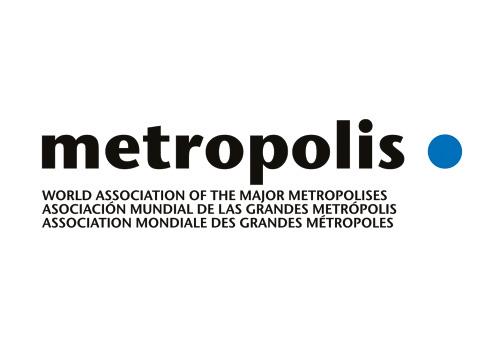

THE STEERING COMMITTEE OF THE ETI CHAIR
Professor Didier Chabaud Managing Director


Professor at IAE Paris, former president of the Academy of Entrepreneurship and innovation, co-editor in head of the Journal of Entrepreneurship (classified A HCERES), Didier Chabaud has written about one hundred journal articles with peer-reviewed journals, book chapters and publications, on the entrepreneurial processes.
Associate Professor at IAE Paris, pioneer of the concept of “Living Cities”, Carlos Moreno is a well-known scientist in France and in the world. He is a member of the Scientific Committee of the Higher Council of strategic training and research, of the scientific council of the “Institut Mines-Télécom” and the academic board of the Strate Design School in Singapore. Carlos Moreno was awarded the 2019 Prospective Medal by the Architecture Academy.
Lecturer at the Sorbonne School of Managemsent, Florent Pratlong is an innovation specialist, in charge of the managemsent of innovation Masters degree at the University Paris 1, Commission Secretary at the Technology Academy, participant in the actions of the Paris Club of the Directors of Innovation, he designed and deployed innovation training programs and “Learn ing expeditions “.
Expert in Innovation
Formerly held the position of Interna tional Executive of the Steelcase Group for many years. In particular, she led the Action Research projects on La bor Prospective until 2018. She then directed “thecamp”, a unique campus of the future dedicated to positive in ter-company innovation located in Aix en Provence. She is now passionate about creating programs and expe riences that foster creative thinking, encourage collective intelligence and accelerate the experimentation of new ideas at the scale of a company, a city or a territory.

EDITORIAL
Pr Carlos Moreno Scientific Director and co-founder of the ETI Chair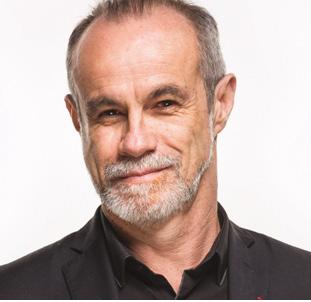
From the moment we are born to our last breath, the urban environment is the primary universe, space and time of humans. The issues at stake in the urban transformation are ecological, social and economic, centring on the citizen. Technology is not an end in itself – it is but a catalyst, albeit an extremely powerful one, in this transformation process.
Nonetheless, the digital revolution, and in particular artificial intelligence, is profoundly modifying the urban environment as phenomenon, all over the world. This dimension prompts us to add a new component to qualify the city of the 21st century: the ubiquity, or the ability to enjoy a technological connection anytime, anywhere, for as long as we need.
We are now witnessing the convergence of open data, digital mapping, geolocation and the co-construction of new services. Immersed in a socio-territorial environment, data are becoming massive, being processed by algorithms and contributing to the emergence of new services and uses. Transport on demand, car sharing, multi-modal mobility, decentralised energies, heritage showcasing, inviting urban public spaces, personalised healthcare, better quality of living for the ageing and elderly, massive online education, open arenas for culture, art and leisure, participatory democracy under open governance systems, collaborative information systems, and more: these are just a few examples of the services that are emerging today, and which will make the city of tomorrow a living, breathing place, where smart cities, social inclusion and technological innovation will become one.
Yes, with climate change and in the age of Covid-19, the role of digital and AI applications will be crucial for the years to come. We want AI that serves humans, cities and citizens, to help improve their quality of living, not subject it to its rules.
It is with great pride that we present to you this collection of texts, which is the result of the considerable work carried out by Hubert Beroche during a world tour of AI. Capturing the many facets of the research and experimentations being carried out on and with AI is of essential importance, in our eyes, to bring out new food for thought and action on this key topic.
SUMMARY
1. On this line of research, see the URBAN AI report (Hubert Beroche).
INTRODUCTION

This publication extends from a world tour of “Urban AI”, on which I embarked from July to December 2019. Over a period of 6 months, I explored 13 cities and met with nearly 130 AI players, in search of the answer to a single question: can AI help us create sustainable cities?1
The project, carried out in partnership with the ETI Chair, gave rise to multiple analyses, thought processes and debates around the topic “AI and Cities”: will we live in cities under surveillance? How can autonomous mobility be used to serve our territories (rather than the other way around)? Is AI going to kill our cities? Are we witnessing the advent of invisible cities?... This publication is an attempt to respond to all those questions (and many more!). However, far from wrapping up the discussion, it aspires to open up new horizons, and stir new questions.
AI is a phenomenal technology that has already revolutionised our lives and is on the verge of transforming our cities. However, on its own, AI is but a tool – a pharmakon, as Bernard Stiegler would say. Now it is up to us to take hold of this technology to take up the major challenges of our time and take action for a better world. Taking hold of a technology does not just mean developing or using it. It means understanding it and taking ownership of it so that it cannot enslave us. It means taking the time to explore all the possibilities it holds to bring about a desired and desirable future. It means, lastly, making sure that it serves our humanity and our ideals.
THE LIVING CITY

THE LIVING CITY: EXECUTIVE SUMMARY
In so many respects, Artificial Intelligence (AI) appears to be a threat to the vitality of our cities. First of all, for ontological reasons. We know that, at the dawn of the 20th century, Bergson taught us that intelligence cannot grasp the living2. Even worse, it is antinomic to it. And for good reason: where intelligence is essentially analytical and therefore mechanical, the living is spontaneous and organic.
correlations between the components that structure a space and its vitality, foster diversity in uses and contribute to the creation of 15-minute cities.
While AI does entail certain dangers for the vitality of our cities, these stem mainly from its use. As the history of cities shows us, the creation of rationalised and segmented spaces is not specific to a particular era or technology.
And a city is a complex metabolism, imperfect but alive. It develops, shaped by flows, its streets traced by the erratic current of life (what Le Corbusier, with some disdain, called “the pack-donkey”s way”3). A place of intermingling and sharing, the urban space is in perpetual mutation as the seasons and generations change. As such, AI seems off to a particularly poor start when it comes to contributing to the vitality of our cities. It could even be said, following Bergson”s logic, that AI is programmed to create mummified, stillborn cities. Common sense and the collective imagination moreover seem tilted in this direction. It is the custom, when imagining a city designed by an algorithm, to visualise a cold, metallic and mechanised city.
This apparent antinomy is reinforced by a technological component: Machine Learning, which can, by definition, analyse only existing data. Spontaneous creation, the unpredictable, the evolution of uses... in short, everything that characterises the vitality of a space should thus be foreign to it4.
However, it is precisely this capacity to analyse a colossal amount of existing data that makes AI so attractive for the planning of our cities. Whether using Reality Mining or Web Mining, AI is capable of explaining patterns (models) in order to better understand territories, infrastructures and uses. Better still, as we will see later, it can identify
The antinomy referred to above serves as a reminder that AI is not the response to the major urban challenges of the 21st century, let alone an end in itself. On the other hand, hybridised with other techniques and dedicated to serving a humanist vision, it can contribute to an enlightened future and the creation of living cities.
2. The Creative Evolution, H.Bergson
3. Urbanism, Le Corbusier
4. In Amsterdam, Alessandro Bozzon (TU Delft) confided to me that “AI just predicts the past”.
FOCUS Cityscope : AI for enlightened urbanism
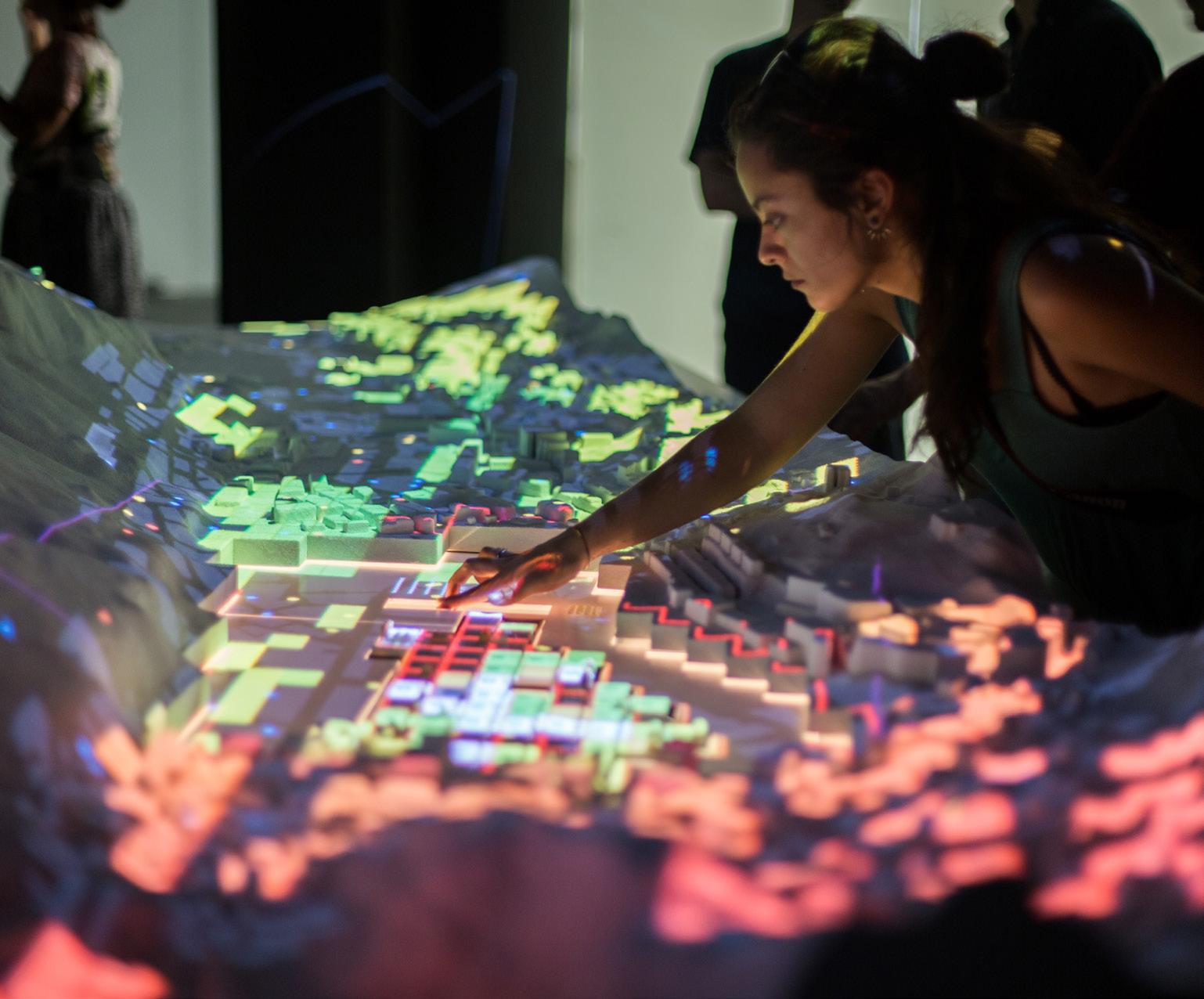
WHAT IS CITYSCOPE?
Invented in 2013, CityScope is a surprising urban planning platform, to say the least. To put it simply, CityScope is entirely made of Legos: car parks, parks, hotels, shops, etc. -all the infrastructures found in the city are depicted in the Danish giant”s famed building blocks. Better still, they are arranged and distributed according to the geography and urban planning of the city to which the platform applies.
One of the key aims enabled by CityScope is a better visual understanding of the transformations brought about by urban developments. The Lego model is thus connected up to software, which evaluates, in real time, the changes (social, economic, demographic, etc.) brought about when one of the building blocks (which represents the city”s infrastructure) is moved. The software is powered by several indexes (social diversity, air pollution, etc.) which evolve according to the urban transformations imagined. For instance, adding a shop to a neighbourhood can increase its economic health index but could also lower its social diversity index.
Used by more than 15 cities around the world, CityScope has shown its mettle in Hamburg in particular, where it contributed to managing the migrant crisis. CityScope offered up avenues for short-term solutions (by estimating the accommodation capacity of the city”s infrastructure), but above all, helped to identify the neighbourhoods where migrants have the best chances of integrating.
THE EXAMPLE OF ANDORRA
Noyman, A., Doorley, R., Xiong, Z., Alonso, L., Grignard, A., & Larson, K. (2019). Reversed urbanism: Inferring urban performance through behavioral patterns in temporal telecom data. Environment and Planning B: Urban Analytics and City Science, 46(8), 1480-1498.
CityScope can also be applied to identify uses and analyse how individuals take ownership of a territory. This is one of the main reasons for which the platform was deployed in Andorra. For this project, the City Science Group teams began by gathering behavioural data. In so far as the Principality has but one telecom operator, the teams from MIT were able to anonymously analyse the movements of a large part of the Andorran population (70,000 data points per second for a population of 76,000 inhabitants). This dataset was then coupled with other information related to Andorra”s infrastructure and facilities. It is precisely at this point that AI comes on the scene. It uncovered correlations after combing through huge amounts of data.
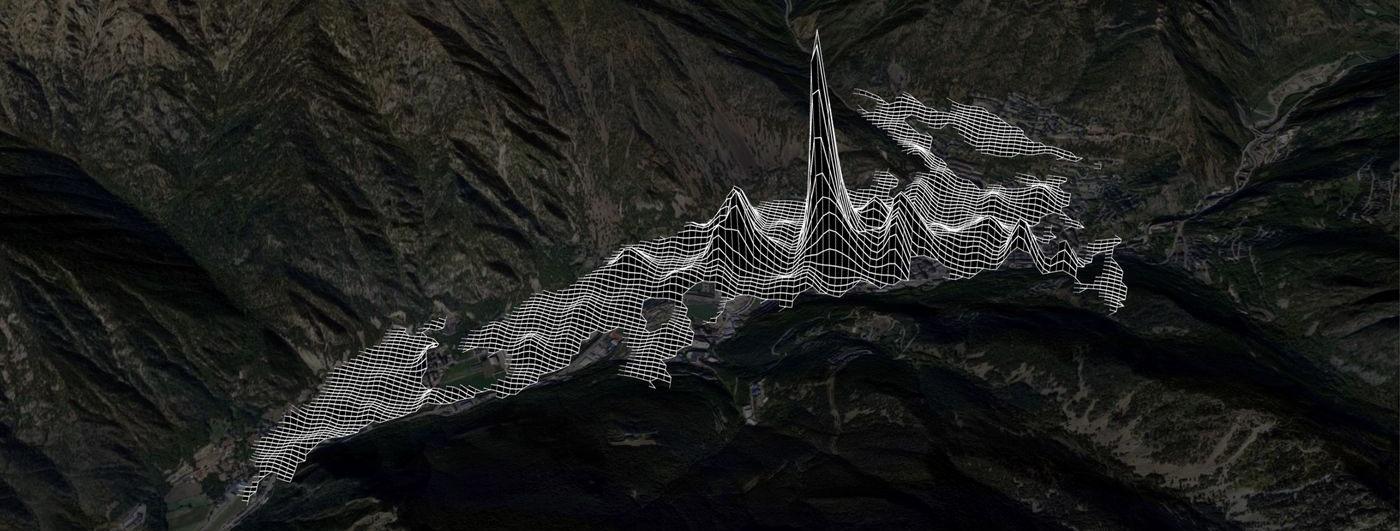
This project has yielded several particularly interesting results: spaces close to a school tend to be less lively (where Andorra is concerned). In contrast, religious structures appear to enhance the vitality of a public space. Furthermore, a positive correlation was observed between a square”s cultural diversity and its vitality. CityScope also revealed some surprising results. One of them is that parks diminish the attractiveness of an Andorran space. This trend is in fact attributable to the fact that Andorra is bordered by beautiful mountains and green spaces. Andorrans, and especially tourists, are therefore more inclined to leave the city in search of peace and greenery.
Enlightened and transparent urban planning
CityScope thus makes it possible to grasp a city in its singularity and understand its uses. In this respect, it represents a formidable tool for regional planning. Here, AI makes it possible to undertake enlightened urban planning, for the benefit of the citizens.
A digital and open version of CityScope is also available on-line. As these examples illustrate, this technology is used by people the world over. Notwithstanding, CityScope”s real added-value lies in its physical interface. Legos naturally encourage people to try out different arrangements. The result is a co-governance of sorts, which promotes transparency and exchange.
ENCOUNTER
Alex Pentland
Computer Scientist and Professor
Alex `Sandy” Pentland directs MIT”s Human Dynamics Laboratory and the MIT Media Lab Entrepreneurship Program, co-leads the World Economic Forum Big Data and Personal Data initiatives, and is a founding member of the Advisory Boards for Nissan, Motorola Mobility, Telefonica, and a variety of startup firms. He has previously helped create and direct MIT”s Media Laboratory, the Media Lab Asia laboratories at the Indian Institutes of Technology, and Strong Hospital”s Center for Future Health.
What is social physics ?
Social Physics is a very old phrase. It’s about 200 years old, created about the time that natural science turned into physics and alchemy turned into chemistry. There was a French scientist who said maybe we could use statistics and data to understand the change of culture and that’s why we have a census today. The problem they had though is that they discovered they didn’t have very good statistics and they didn’t have much data so they renamed the science as sociology. But today we have lots of data and we have a very fancy, powerful statistics so we can understand the ebb and flow of people and of culture much better than we ever could before.
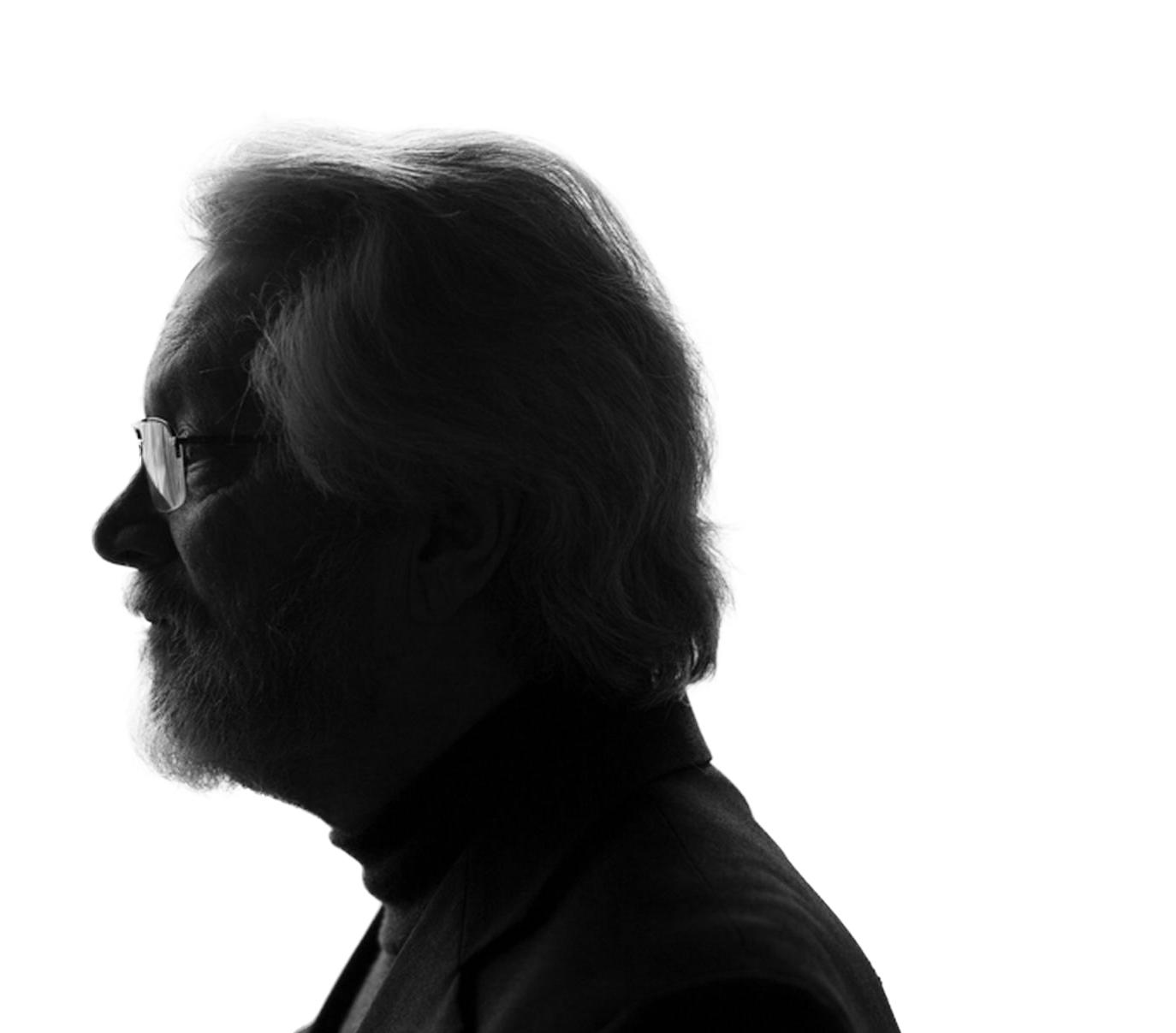
How can social physics help us create better neighborhoods ?
I’ll give you sort of really top-level overview. It turns out that if you look at the flows of people going into and out of the neighborhood you can predict quite accurately how much money that neighborhood will make the following year. Are they getting richer ? Are they getting poorer ? And if you see that the flows are collapsing in a particular pattern, then that means that neighborhood is very likely to have more crime in the following year. Thats a very powerful understanding, that to be able to promote diverse flows of people into a neighborhood is something that is a precondition and a strong predictor of the neighborhood getting better. Subjectively, it feels like the neighborhood is alive and change is happening. This broad patterns show up in all sorts of data…transportation, purchasing, etc…so it is easy to to see which way the neighborhood is going and, once you know about this pattern, to figure out what should we do in that neighborhood to improve conditions.
You said, “Human organisations are like AI network””, what did you mean ?
The classic understanding of humans is as individuals, and for instance economists take them to be rational and self-seeking and independent of everybody else. But that’s not the way people really are. People have connections
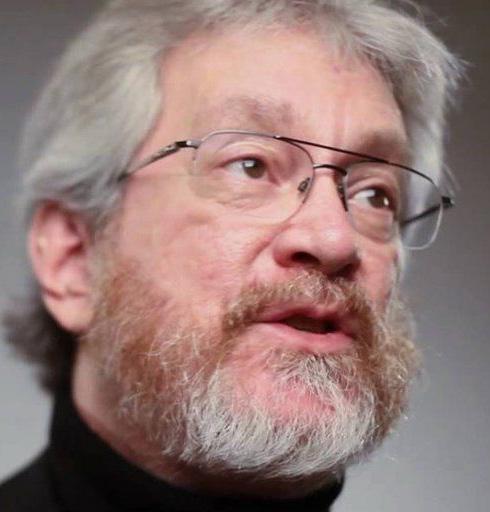
with everybody, they learn from everybody. They try to fit in so that they copy everybody. A better model of humans is that they are part of a large social network, and the structure of the city and the network of communications shapes the network of interactions.
This is exactly like how AI networks work. They have a bunch of nodes that are connected randomly and what the AI tries to do is make the connections work better.
Social physics tries understand how these networks shape behavior, innovation, and quality of life, and the
science says that more diverse connections results in better outcomes for each neighborhood. Why is this true? The reason is that if you have more diverse connections you have more access to diverse opportunities. So it’s not about money, it’s not about the educations, instead it’s about access to opportunities. Opportunities flow on networks. You tell me about somethings, I show you something…that’s the stuff of growing society, and that’s where innovation comes from. By cultivating that network, by putting the busses in the right places by putting the stores or the city halls in the right places, we can get more diverse mixing in the city and get better outcomes as a result.
But it looks like AI is more used to improve connections than diversity…
This one of the things that is wrong with AI today, it’s that by thinking about people as individuals who have these properties that are just yours [indepedant of anybody else] we build algorithms for matching with people just like us. This sort of similarity matching is what you see in apps like Tinder, like Amazon and that’s the source of echo chambers. It’s narrowing, it’s bad for society. If you think about people as part of a social network, then for the people to be healty they need to have diverse connections. You must build apps that get youconnected to different sorts of things and different sorts of people. And that contributes to build a better society.
URBAN GEMS
AI serving the 15-minute city
The ETI Chair has joined forces with ten or so partners, including Inetum, the City of Paris and Paris&Co, to develop a platform for analysing the territory and infrastructures. The platform”s objective is to determine whether a district and/or a city meets the requirements to be a “15-minute city”. In other words, whether all the inhabitants of a given space have, within fifteen minutes of their homes, access to the six essential urban social functions: living, working, supplying, caring, learning and enjoying. To do so, the platform uses different AI technologies (computer vision, NLP, web-mining,...) in order to automatically characterise these social functions, based on infrastructures and services. These data are furthermore aggregated and used to calculate a High Quality of Social Living Index that measures the well-being and sociability of citizens and their aptitude to work sustainably for the planet. Interestingly, one can observe that this platform also has a citizen interface through which individuals can access all the aforementioned information and thus become better acquainted with their territory.
This platform is able to identify white zones (where social functions are lacking), model a territory”s urban trajectory (demographic evolution, incipient gentrification, etc.) or contribute to the development of polymorphism in services through the creation of multi-purpose infrastructures. Here, AI serves as a decision-making tool for the various stakeholders in the city and contributes to the deployment of a balanced network of services. This technology is being developed in particular in the 18th and 19th districts of Paris and part of the communes of Pantin, Aubervilliers and Saint-Denis.

SOCIAL GLASS: DATA PUT TO WORK FOR USERS
In Amsterdam, the Delft University of Technology has joined forces with the Amsterdam Institute for Advanced Metropolitan Solutions (AMS) to develop the platform Social Glass. The latter leverages web mining on social media (Twitter and Instagram) to better understand how individuals take ownership of the city. For this purpose, Social Glass collects and analyses different types of data, including geolocalised unstructured images and text. The platform can thus calculate a location”s popularity, a neighbourhood”s demographic make-up and even tourist flow (and country of origin). Once aggregated, these data make it possible to anticipate affluence and congestion phenomena and to visualise how the city is perceived by its inhabitants. This technology was also used by the City of Amsterdam to analyse the reaction of inhabitants to ephemeral developments and to gain a better understanding of selected exceptional events (festivals, exhibitions, etc.).
ARETIAN: FROM A TERRITORY”S “KNOW-HOW” TO ITS RICHES
In Boston, start-up Aretian uses Machine Learning to identify a city”s economic identity. This is what Ricardo Hausmann calls “know-how” – in other words, the body of knowledge which a city can mobilise to produce wealth. In this context, there are five types of districts: “industrial”, “governmental”, “academic”, “entrepreneurial” and “other”. Each of these typologies has its own demographic, social and financial characteristics. Armed with this knowledge, a city can carry out improvements to and make investments in the urban environment, to update (as Pittsburgh did with its industrial districts) or redirect (as was the case for Kendall Square in Boston5) a district”s “know-how”. These data also provide a better understanding of a territory”s economic trajectory, as some neighbourhoods are likely to create more jobs than others and/or be more innovative. As such, this practice paves the way for increased urban planning where the economic complexity of a neighbourhood becomes a source of fulfilment and prosperity.
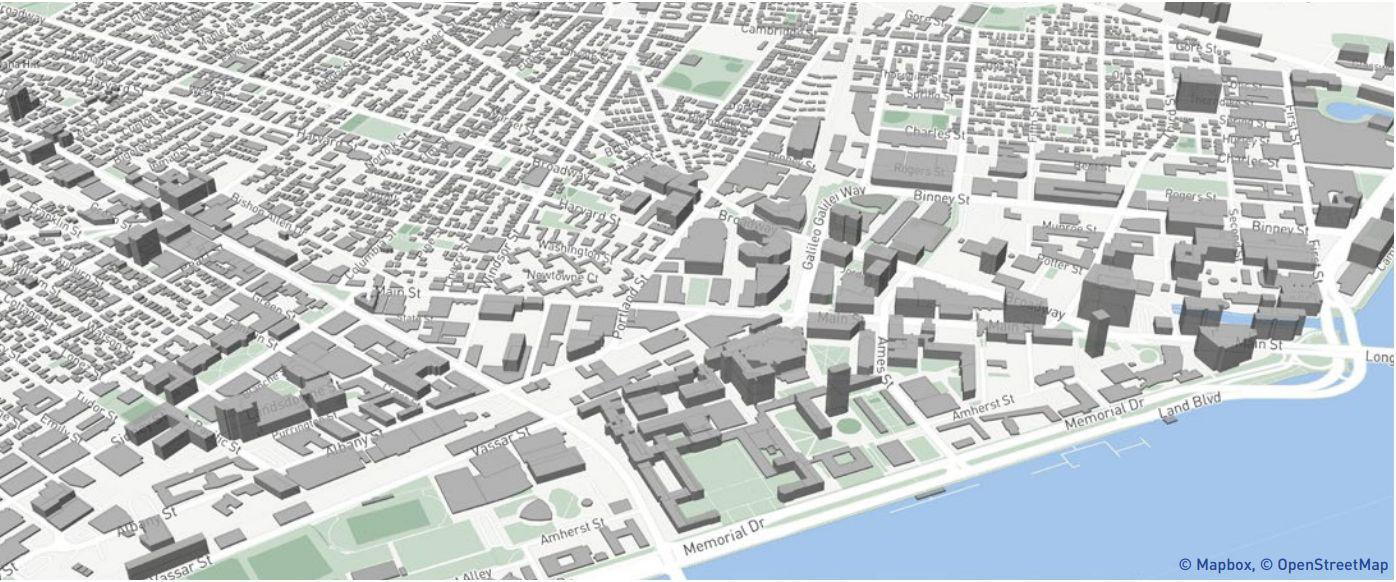
THE HUMAN CITY
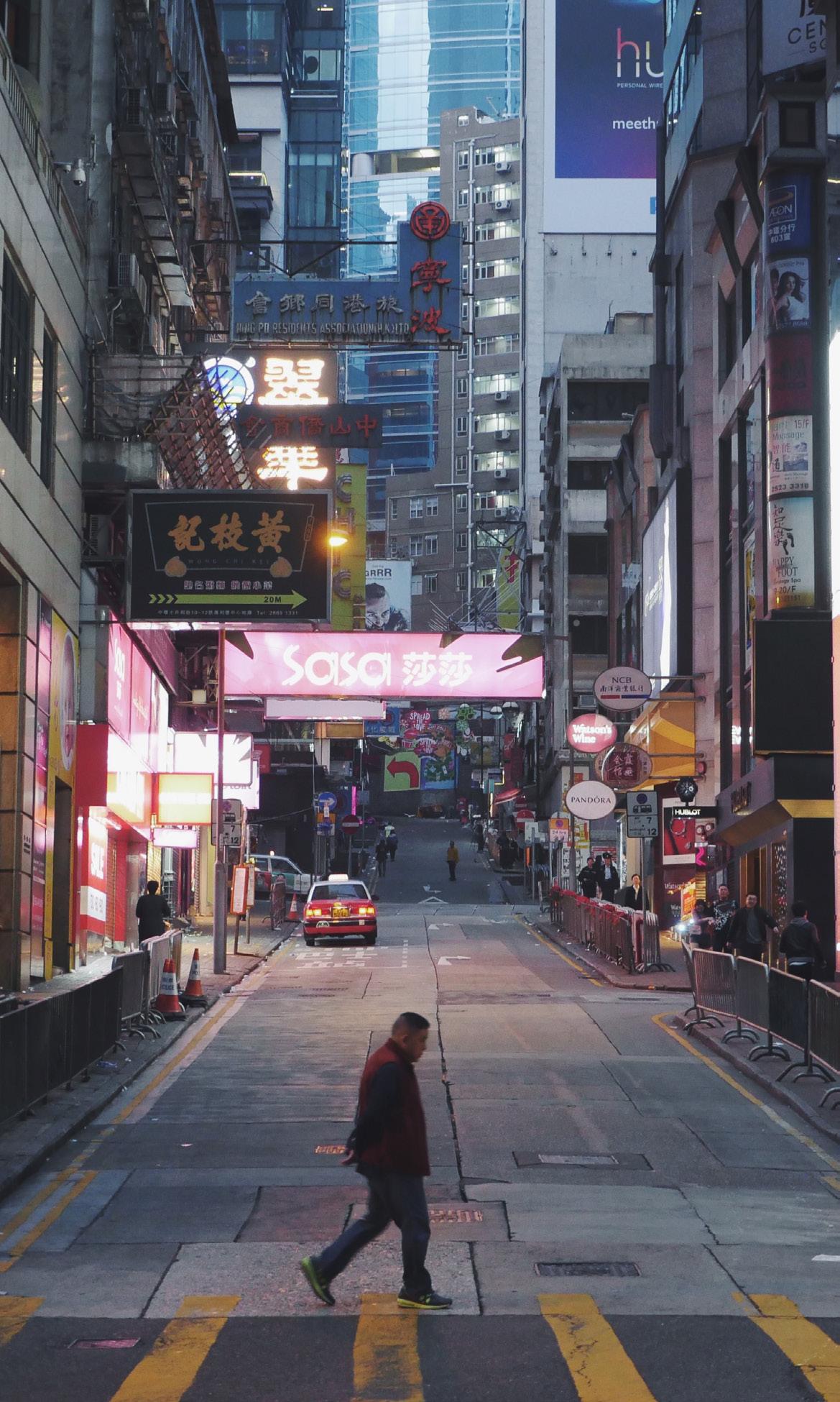
THE HUMAN CITY: EXECUTIVE SUMMARY
One of the main risks of AI lies in its potential to contribute to the creation of “invisible cities”. Mesmerised by their smartphones, individuals turn into “smombies”6 impervious to the beauty of the urban environment. Over-optimised by the presence of digital twins, our cities become fluid, service-oriented and “user-friendly”7. “User-friendly”, in that cities begin to function much like ergonomic applications: friction-free. Yet spaces where there is no friction can be often crossed through, but rarely entered, let alone inhabited. In this sense, the urban environment is above all frictional. And rightly so, for cities are characterised by their ability to produce the unexpected and spark the mind.
However, the urban is not only a breeze of freedom that crosses the city12, it is also a story bearing meaning and values. A city is liveable to the extent that it echoes our humanity. In other words, to the extent that it expresses a history, a feeling, a truth... In this manner, the urban word enables a dialogue between the city and its inhabitants. The Senso-Ji Temple in Tokyo, the Pont des Arts in Paris or the Rambla in Barcelona actualise our human condition by reminding us that “poetically, humans dwell on this earth” (Hölderlin).
The ability of cities to produce the unexpected starts first of all from their physical reality. Streets, squares and public spaces in general are places of encounters and exploration. Encounters with other individuals and explorations of new uses/cultures. Whether through improvised performances, window displays8, monuments or even just a face9... the city dweller is constantly under the temptation to deviate (in the literal sense of diverting from a trajectory). And, much like the epicurean clinamen10, this deviation gives rise to freedom. The freedom to amble and roam new imaginary worlds. The freedom to undertake and break free from social determinism... At the individual level, these freedoms offer us the possibility for self-accomplishment, and collectively enables us to develop.
City dwellers guided by AI are blind to these possibilities in the urban environment. Shut away in an echo chamber, they find only themselves where the city was offering them otherness. When optimised, individuals work along an itinerary, a user”s route, a recommendation... in short, a programmed trajectory. Once a space of the unexpected and of metamorphosis, the city becomes a “smart prescriptive city”11, a labyrinth.
6. Suitcase word formed from smartphone and zombie to refer to city dwellers who are constantly looking at their phones.
7. Richard Sennett, Building and Dwelling: Ethics for the City (2018)
8. On the structuring nature of urban showcases and the influence of digital technology on them, we invite the reader to read this article
9. The theme of the face as an invitation to stroll in the city has been developed by Aragon in Aurélien
Instead of operating according to the modalities of dialogue and interaction, the digital infrastructures that underpin AI are too often unilateral and mute. In the face of these information systems, the individual becomes data stored and then used. In other words, a resource. In other words, a resource.
This dehumanising relationship between digital infrastructures and citizens has something of Valdrada, the city imagined by Italo Calvino in his Invisible Cities:
“
Thus, the traveller, arriving, sees two cities: one erect above the lake, and the other reflected, upside down. Nothing exists or happens in the one Valdrada that the other Valdrada does not repeat, because the city was so constructed that its every point would be reflected in its mirror, and the Valdrada down in the water contains not only all the flutings and juttings of the façades that rise above the lake, but also the rooms” interiors, with ceilings and floors, the perspective of the halls, the mirrors of the wardrobes. Valdrada”s inhabitants know that each of their actions is, at once, that action and its mirror-image, which possesses the special dignity of images, and this awareness prevents them from succumbing for a single moment to chance and forgetfulness”.
10. In Epicurean physics, clinamen refers to the deviation of atoms from their vertical fall into the vacuum. This clinamen breaks “the laws of fatality” (Lucretia), generates the meeting of bodies and gives birth to freedom.
11. Richard Sennett, Building and Dwelling: Ethics for the City (2018)
12. Germans like to say that “there is a wind of freedom blowing in the city” (Stadtluft macht fre).
Similar to Valdrada, our cities are reflected in a lake -- a data lake. With the difference being that we have no access to our reflection.
Whether through digital infrastructures or optimisation applications, by turning to AI, we thus run the risk of creating invisible cities (virtual, mute, bereft of meaning, ...). To obviate this, we must reverse the paradigm and urbanise AI.
URBANISING AI MEANS:
FORMING A SOCIAL CONTRACT AROUND AI AS TECHNOLOGY
In order that Man does not become (again) “a wolf to Man”13, we must agree on a common political vision around (urban) data. Cities, companies, academic centres and citizens must come together and reflect, jointly, on the use they want to make of AI. While multiple technical tools (data banks, data trusts, blockchains, etc.) can be used as vehicles for these discussions, in the end it is a political agreement that must be reached14.
GIVING PREFERENCE TO THE INTERFACE OVER DIGITAL INFRASTRUCTURES
The digital infrastructure operates on the modality of invisibility15. In most cases, citizens” data are collected without their knowledge of it (through their smartphone, a Wi-Fi box or other almost imperceptible sensors). As stated earlier, the citizen consequently becomes an urban data item. To reverse this paradigm, we need to give substance to the digital. In other words, having it (re)materialise. In this respect, the interface offers a platform for interaction between the individual and the data by giving material form to the digital. Even better, it creates the possibility to enter the digital space16. It is for this reason that the interface must be given priority over the digital infrastructure or, at least, be associated with it as often as possible.
CREATING DEVIATING ALGORITHMS
Applications and systems supported by AI too often rely on optimisation algorithms. As a result, they generate an urbanism of the invisible and echo chambers. To urbanise algorithms is to use freedom and exploration as the reference points, instead of optimisation and exploitation. It means opening up a realm of possibilities rather than an optimised itinerary. It means creating digital cities that are representative of our identities and lend themselves to our ambling. Last but not least, it means leaving enough space to the cities so that they can express themselves and catch us by surprise.
13. T.Hobbes, Leviathan (1651)
14. This theme will be discussed in more detail in the Citizen City and AI chapter.
15. For more information on this point, we invite the reader to consult: Catherine Di”Ignazio, Eric Gordon and Elizabeth Christoforetti,
Seamful Interfaces for A Community-Centered Smart City.
16. The situated citizien, Marius Hartmann in URBAN AI (Hubert Beroche)
ENCOUNTER
Saskia Sassen
Professor
Saskia Sassen is the Robert S. Lynd Professor of Sociology and Member of The Committee on Global Thought at Columbia University. Internationally recognized for her work on globalization, immigration and inequality, she wrote “The Global City” (1991) and, more recently, “Expulsions: Brutality and Complexity in the Global Economy” (2014).
Cities do enable the powerless in ways that a small town might not. The large city is a type of complex mixed space that cannot be fully controlled. You can control a small town, but not a large real city –not a privately owned city but a big, messy, 24 hours city. In that context, the powerless, the poor, the disadvantaged are enabled in small and big ways. Small in that at home they are the masters of their domains, no matter how small that domain; they can start a little business, they can organize demonstrations against a big local employer. Nothing grand or dramatic, but rather an accumulation of small interventions that contribute to a feeling of “this is also my city.”
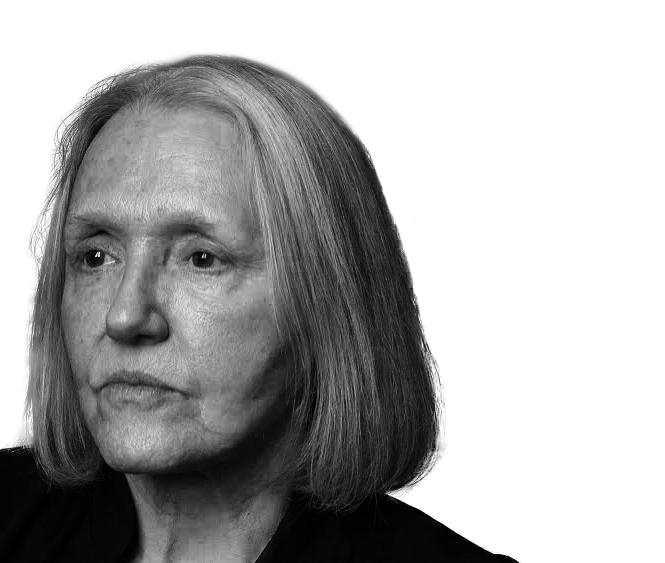
You”ve shown that cities empower powerless people and enable them to realise great things. How could you explain this phenomenon?
You”ve noticed that, gradually, some cities have lost a certain capacity to tell us a truth (with the example of the British style house which is actually owned by Qatar”s investment funds). But what”s wrong with that?
You are right in asking: what is wrong with that? Nothing. My observation or comment comes from a specific angle: the capacity of the material –whatever the materiality in play (a building, a person, a cloud…)- to make itself visible, and in that sense, accessible : “we get it…we understand it… we can see it…”
stand by it. The core notion is a major city cannot be fully controlled, cannot be domesticated. It will always confront us with the unexpected, the surprise, the barrier that prevents us from reaching something, the pathway that allows us to get further than we thought we would…. and so on –This is the city hacking technology.
On the other hand, technology can cut through some of those long lived urban capabilities, it can alter the ways in which people move –now they do not need to meet with the person they want to speak with, they can communicate in many different ways. The value of certain types of knowledge about cities are partly, and only partly, replaced by the fact that we have digitized much of the key features of a city.
How AI can help us create incomplete and complex cities?
It looks like cities are seen as many things (economic assets, places of power, etc.) but not as a material reality. Are we going to live in invisible cities?
In my reading the material matters enormously, but the material needs to be mobilized, constructed, developed, made to fit, if it is going to work. Therein lies an irony: with all its power and weight, it needs , what we might call today “the little people” –the builders, the cleaners, the drivers, the fixers, the painters. All that materiality without people –the people being the weak compared to the heavy and grand materiality of big buildings—is dead stone, dead cement, dead structure.
In this same keynote you explained that cities can help us take our distance with surveillance systems. However, it looks like cities are precisely the most adapted spaces to monitor people…
By itself it does not move very far… even if increasingly we have developed capacities that allow machines to function quite autonomously (the big computers crunching the numbers for financial firms are one powerful example… ). But the context of the city shows the limits of that autonomy. If there is one key path that needs to be activated –as in computers doing high finance—computers are the queens, and they are autonomous queens to a very large extent. But, no matter the complexity of these operations, it is just one element in an ocean of elements. That is the intriguing element of cities: an ocean of elements, and they more or less have to adapt to each other, need each other –even the computers need repair man. I do mean that literally, not fancy computer geniuses, but elementary cleaners
In a 2017”s keynote you said that technology can hack cities, but also that cities can hack technology. How is it possible?
I love this idea of mine…it goes back years… I still
Yes, you are right in emphasizing that surveillance systems get to be very effective actors in cities. And yet, it is my mode to be engaged precisely that kind of self-evidence. It is a provocation, I want to contest it, see what are the limits of that self-evident power of these technologies…what is it that can unsettle that power, that self-evident superiority of a technology over the mere human capacity. Again, it is my search of what unsettles the self-evident superior power, and often what unsettles is not another big power, but the diverse microstructures that constitute the layers after layers of what we think of as weak powers –like people, specifically people as individuals.
URBAN GEMS
MATERIALISING DATA
For the Paris Senseable City Guide, several MIT students designed possible interfaces with which to enhance the Gare de Lyon rail station. One of these proposals included using AI to create an interactive environment. This environment would respond to surrounding events as well as to the station”s uses and users. The station”s ceiling could point out emergency exits in the event of an incident, change colour depending on the crowd”s emotional state, or help passengers find their train. In such a station, the individual could interact with the data and even enter the digital space. The same thinking can be found at The Light Creature, a hotel in Sao Paulo with an intelligent façade of which city dwellers can take control, using their smartphone17.
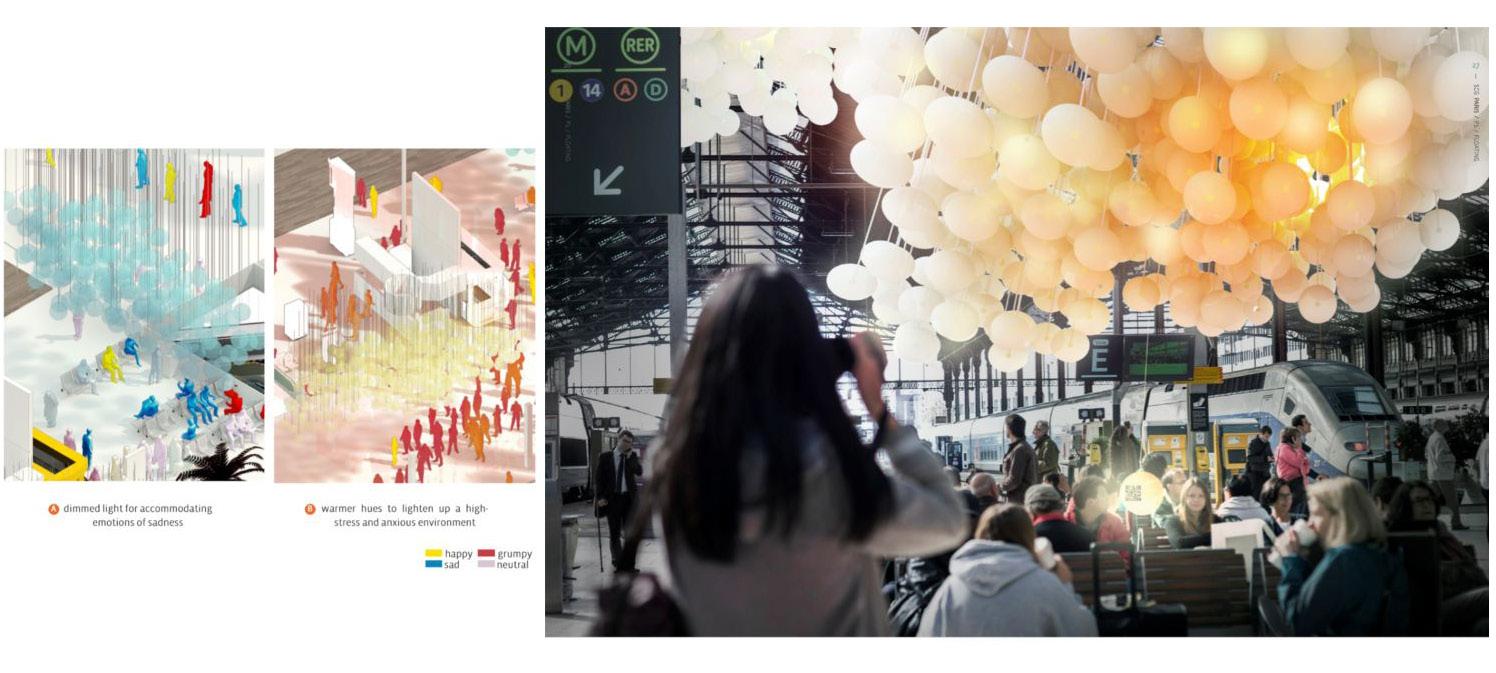
17. For more information,
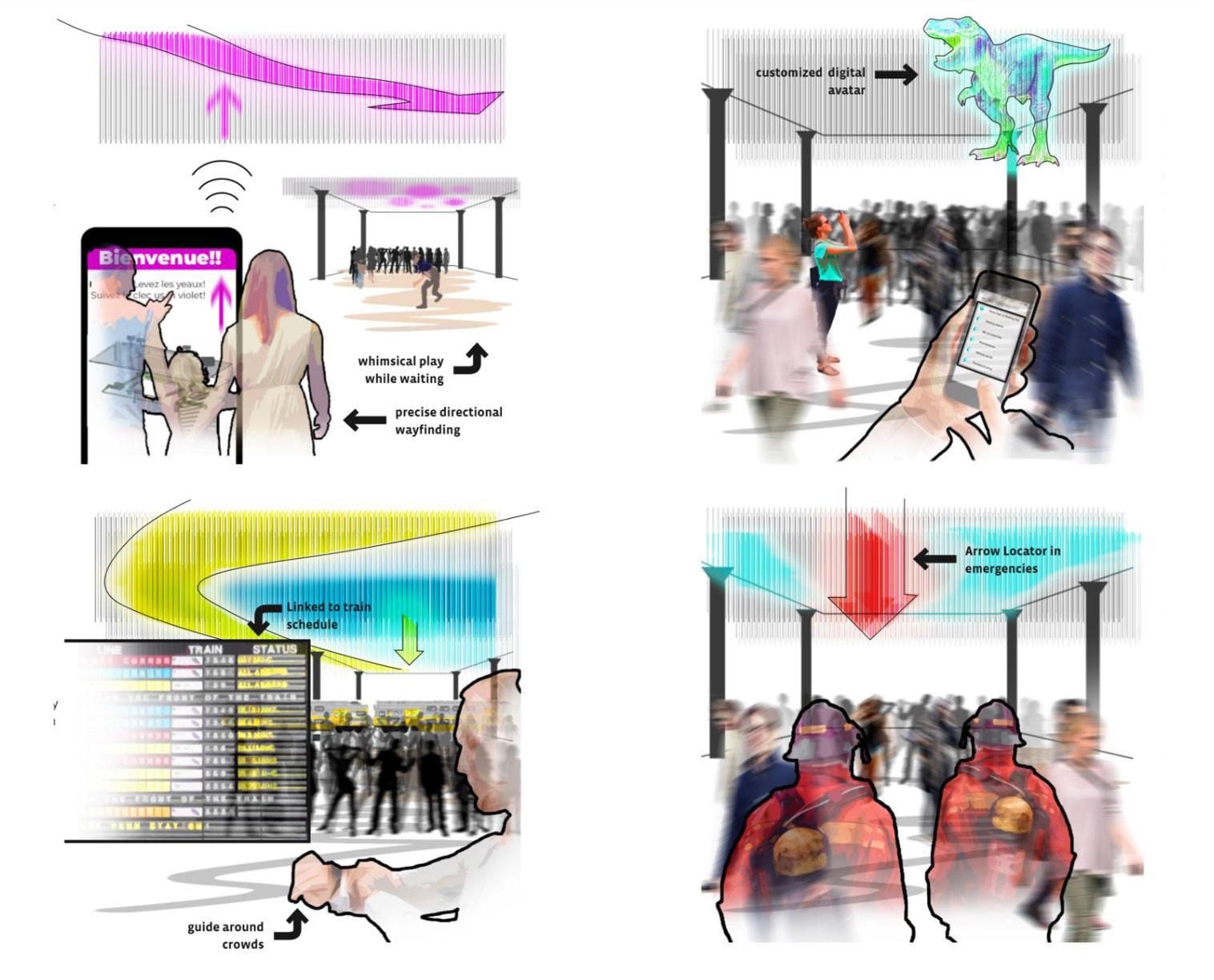
A DIGITAL CITY REPRESENTATIVE OF WHO WE ARE
The Arab Spring or the Occupy Wall Street movement illustrated how digital media could take hold of the city. Conversely, urban phenomena (congestion, matches in a stadium, parades,...) naturally influence these media as well as the activity and content of social media postings.

In Montreal, Philippe Beaudoin is currently creating Waverly, an AI start-up that will enable its users to better manage and control the information they consume. The majority of social networks and digital media offer content based on users” psychological profile and political preferences (identified using AI). By doing so, they create echo chamber effects and polarises our societies. Wishing to remedy this situation, Waverly will develop empathetic AI designed to take into account our deep aspirations, rather than weak signals (clicks, likes, scrolling). This AI”s endeavour is to offer more nuanced and eclectic content while taking into account our singularity. What”s more, users will be able to monitor their data trails and understand how these are used by the application. The idea here is to provide a transparent solution that offers content based on criteria other than optimisation.
“WALK AND DREAM”
In Building and Dwelling, Ethics for the City, Richard Sennett makes the distinction between two types of “smart cities”: prescriptive and coordinating. In the first instance, technology is an injunction, guiding (often without their knowledge) the citizens. In this sense, it becomes “user friendly”. Richard Sennett offers a number of examples including that of a tourist who, wishing to have a coffee, looks up Starbucks on Google Maps, rather than taking the time to discover the city. The multitude of options, landscapes and trajectories at his feet meld into a single optimised itinerary. Originally open and complex, the city becomes closed and simple.
To combat this trend, the think tank hérétique has created its application “Dérive” [Drift]. Dérive works like a compass, indicating no more than a direction, a distance and the address of the destination. It is then up to the user to plot his course and explore the city to find his way. Technology thus becomes a springboard for wanderlust, inspiration and, above all, freedom (what Richard Sennett calls “the coordinating smart city”).
FOCUS Topos or using AI to identify the “personality” of cities
When is a neighbourhood said to be “typically Parisian”? Where does “New York energy” or the “California vibe” come from? More broadly speaking, how does a city manage to give off a culture, an imaginary world or an emotion? The start-up Topos (“place” in Greek) uses several branches of AI technology to answer these questions, and I met up with Will Shapiro, its co-founder.
FROM THE CARTOGRAPHY TO THE PSYCHOGRAPHY OF CITIES
“The usual cartography of a city does not provide any information on what really goes on there. When someone talks about Brooklyn, you think of a uniform, homogeneous entity, when in reality, there are 200 different Brooklyns! ” (Will Shapiro). Working from that observation, Topos used computer vision, Natural Language Processing (NLP) and Network Science to draw New York differently and offer a psychography of the city. In contrast to conventional maps that make geographical connections, the psychography designed by Topos works ontologically. In other words, it suggests connections based on an area”s atmosphere (its visual identity, infrastructures, population, etc.). To achieve this, Topos aggregated and analysed hundreds sets of data (economic, visual, demographic, etc.) from dozens of different sources. The start-up”s resulting new map of New York.
This map, divided into 5 “neighbourhoods” (each depicted in a different colour) invites users to cast a different eye on the city. The neighbourhood in yellow (called “The Meadows”), is peri-urban, sprawling and characterised by abundant vegetation. In contrast, “Minhattan” (the district in green) is particularly dense, has many business and commercial buildings and is the most expensive in New York. This project embodies one of Topos” ambitions: to capture a space”s personality.
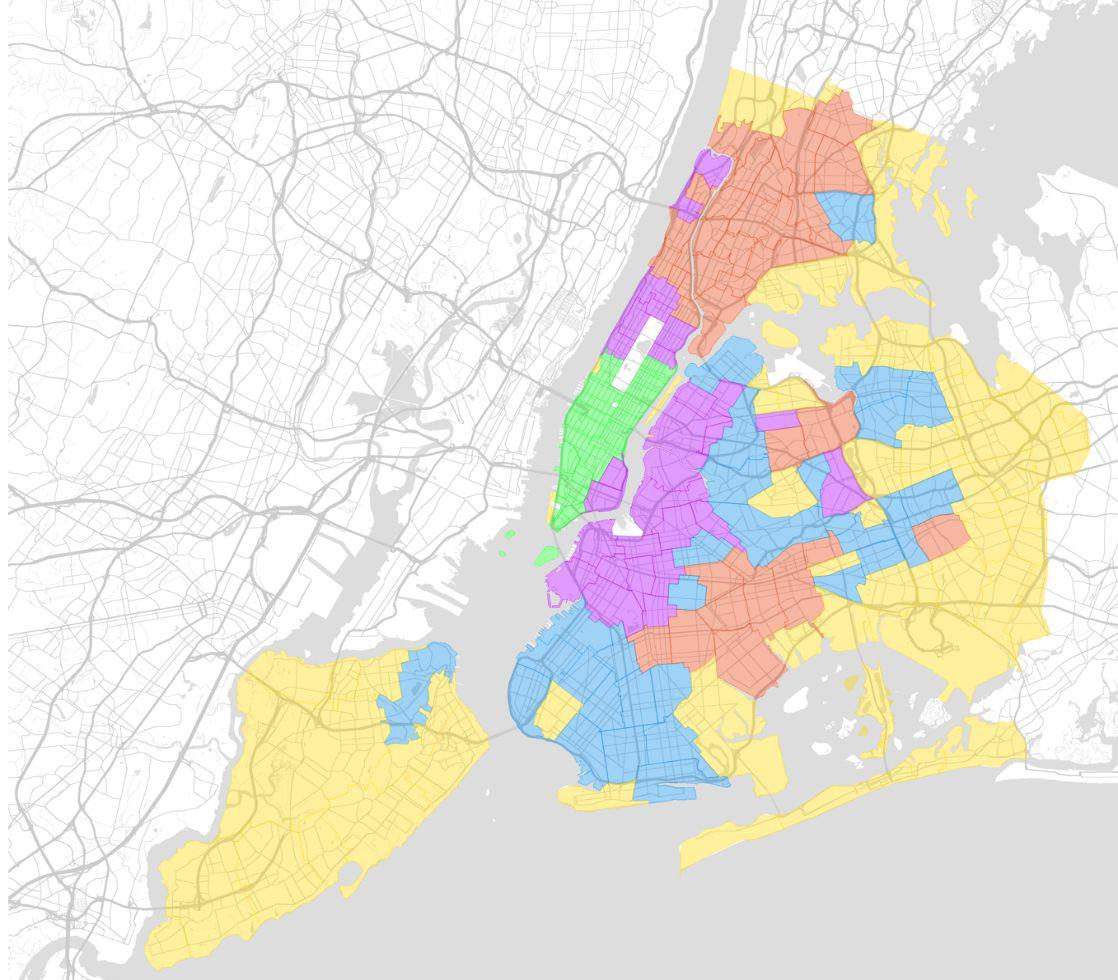
FROM ECONOMIC ISSUES...
The economic potential of such a psychography is considerable. “The idea is to offer a company an optimal location, based on its brand, customer base, etc. in order to help it refine its geographical expansion strategy”. To do this, Topos “matches” the characteristics of the company with those of a neighbourhood (according to its psychography). For example, the start-up was able to identify the specific areas of New York where Dunkin Donuts would be most likely to maximise its income (for more details, see here):
Topos” AI offers particularly high granularity. For a restaurant, it is even capable of determining which dishes are most likely to become customer favourites, based on the neighbourhood. “We noticed that the “Prosciutto Pizza” had a probability of being picked by certain types of populations [such as hipsters]”. It came to that conclusion by analysing, for instance, user opinions of pizza places on-line and combined that information with geographic and sociological data.
depending on the users” responses to the recommendations. At Spotify, the method is all the more effective as people can create their own playlists (and thus, indirectly provide the AI with access to the musical tests of persons in the same group). When it comes to advising its own clients, Topos uses a similar AI: “We see obvious and deliberate groupings. This is the case, for instance, when Burger King automatically chooses to open a restaurant across the street from a McDonald”s. Other choices are more understated. You can see, for example, that WeWork, Sweetgreen and SoulCycle (a fitness studio chain) are often found in the same neighbourhood”. If you want to open a fitness studio with branding similar to that of SoulCycle, you might do well to look for a WeWork location.

In addition to these economic benefits, Topos” AI can also serve social causes. Psychography can identify gentrification trends in progress, and uncover inequalities (as the new map of New York, for instance, reveals). While the start-up does not (yet) work with the cities themselves, one can easily imagine how its AI can contribute to creating more inclusive neighbourhoods.

...AS WELL AS SOCIAL
In addition to its psychographies, Topos uses collaborative filtering to advise its clients. This is one of the methods which Spotify uses to produce its recommendations. The concept is simple: Spotify puts people together in groups based on the songs they have chosen. Its AI then makes recommendations to users in accordance with the music people in their group enjoy. From there, the model becomes more and more refined,
3. THE PROTECTIVE CITY

THE PROTECTIVE CITY: EXECUTIVE SUMMARY
Our century is one during which wars will have become urbanised18. Cities are both the theatre and the target of contemporary conflicts. The terrorist attacks in major Western metropolises, armed clashes in various cities in the Middle East or war scenes in favelas, to name only a few examples, illustrate the violence and scale of this phenomenon. This new urban condition has generated new uses of technology, including the emergence of the “Smart City” (which often boils down to a “Safe City”19). As we will see in this chapter, AI occupies a central place in this new paradigm. The use of predictive policing, facial recognition, gunshot detection, body language analysis, robot-police, etc. are just some of the uses that are extending the artillery of the “Smart/Safe City”.
Surprisingly, the “Smart City” is anything but unassailable. The reasons are, first of all, technological. With digital coming into massive use, new (cyber)-risks are logically coming about. The hijacking of autonomous systems, the creation of Deepfakes or even data poisoning are new ways of taking advantage of the fragility of the city at the expense of its inhabitants. Each of these threats serve as a reminder that the “Smart City” (like AI) is a pharmakon: both a remedy and a poison to cities. The concept of pharmakon20 does not only tell us of the ambivalence of the “Smart/Safe City” (and the AI that stems from it). It also indicates that these surveillance systems are not neutral: specifically, they can distort the urban metabolism.
In order for the city not to become a monstrosity, a leviathan, these surveillance technologies must thus be regulated. Rather than operating according to the modality of the Panoptique21, the “Smart/Safe City” must be open and transparent. In order to avoid arousing fears and mistrust, safe AIs must be fair (at the very least, unbiased) and explainable. And for good reason, as the protective city is not only a “safe city”. It is also an assuaged city, where the togetherness blossoms (and as such, is also a catalyst for safety22).
Let us note, lastly, that the city must also protect its inhabitants from climatic threats (70% of cities already faced with the consequences of climate change). In this respect, the protective city is a resilient city. Here, and as we will see in the interview with Yutaka Matsuo, it is not from Man but from natural disasters that AI can protect us.
18. On this point see Cities at War: Global Insecurity and Urban Resistance (Saskia Sassen and Mary Kal- dor).
19. On this point see La “ ville sûre “ ou la gouvernance par les algorithmes (Félix Tréguer)
20. We take up here the concept of Bernard Stiegler, himself inspired by Jacques Derrida (Plato”s Pharmacy).
21. Prison architecture allowing to see without being seen. On this point see Surveiller et Punir (M.Foucault)
22. Idea notably developed by Jane Jacobs with her concept of the “eyes of the street” in Decline and Survival of the big American cities.
ENCOUNTER
Yutaka Matsuo

Professor
In Tokyo, Yutaka Matsuo (University of Tokyo) used Web Mining to geolocate earthquakes in real time, working from Twitter data. The algorithm”s rate enables it to send alert messages much more quickly than the Japan Meteorological Agency (JMA) in the event of earthquake (and with an accuracy rate of 93%). Yutaka Matsuo uses Machine Learning to automatically analyse the relevance of a tweet with respect to an identified event (here, an earthquake). The mere occurrence of the word “earthquake” or “tremor” in a tweet is not enough to indicate that the author is feeling a tremor and that an earthquake is taking place. Thus AI is applied to refine the semantic analysis and take into account a complex data set (number of words, their order of appearance, etc.). As soon as enough tweets have been deemed “relevant”, the event is considered to be “existent”. The algorithm then uses statistical models to estimate the event”s location and time of occurrence. This algorithm is also capable of estimating the trajectory of a typhoon in real time and detecting many other natural disasters. In each of these cases, the Twitter user is analogous to a “social sensor”.
You used A.I. to help cities fight earthquakes more effectively. Could you explain how it works?
If there is an earthquake, people will tweet “earthquake” or “I”m shaking”. Thus, with natural language processing (NLP) we can detect very quickly the tweets that talk about earthquake happening. However, it is not enough for a tweet to contain the word “earthquake” to describe an earthquake. Hence the need to take into account the context of the tweet and try to extract its meaning. Here, AI is used to sort between tweets relevant for earthquake detection and irrelevant tweets.

Earthquake is a wave, so there is a time lag for example between Tokyo”s shakes and Yokohama”s shakes. If someone in Tokyo tweet “we have earthquake” and several seconds later someone in Yokohama also tweet “earthquale”, we can guess earthquak”s direction and estimate its epicenter. That”s is an example of detecting real world events from social media. We can also use this technology to detect tyhon, flooding or other threats.
This technology has also been used by Toyota to detect traffic jam and accidents. In Singapore, they want to use it in order to detect domestic violence from tweet information and improve crime detection.
You used Natural Language Processing in this technology. How do you think this branch of AI will evolve in the coming years?
Thanks to deep learning, Ais are very strong to detect features,, especially in image recognition. That”s why I want to combine natural language processing with image recognition.
Indeed, understanding of meaning needs imagination. In my definition, understanding means “drawing pictures” in our brain. if we can draw some pictures from a sentence, it means that we can understand it. For example, If I say “a monkey is climbing a tree”, you can draw the picture in your head. That is the most basic form of understanding as a children can understand only concrete things like “trees”, “apple”, “monkey”. Gradually he grows up and then can understand more abstract things. But even if he no longer draws concrete things, he still uses this process of visualizations.
The basic technology to do this is already there. We can use generative model to draw pictures from words. But we need to go further as our knowledges come from our sensations. Thus, it”s not only about associating a word with an image, but with a sensation (smell, touch, taste,…), a feeling..
FOCUS From fake news to the dreamscape city
The “dreamscape city”24 is a term that refers back, in particular, to psychometrics and the work of Michal Kosinski. A professor at Stanford University, he has used Machine Learning to determine an individual”s personality, solely based on their “likes” on Facebook. The algorithm can estimate an individual”s psychological profile, sexual orientation and even ethnic origin 25. Kosinski”s work was subsequently taken up by Cambridge Analytica -- the start-up that notably collaborated with Donald Trump”s campaign teams in 2016. It analysed the Facebook profile, and thus the personality, of more than 87 million American voters. These data were then used to send out messages and personalised fake news to push recipients to vote for D. Trump. This has become known as the Cambridge Analytica scandal.
identify his personality, indoctrinate him (with fake news and personalised messages) and, finally, persuade him to give them access to the urban infrastructures he is watching.
Although fictional, the Army Cyber Institute”s scenario is inspired by several elements of reality, including the Cambridge Analytica scandal. In India, too, the propagation of fake news has already led to acts of violence and even murders. In each of these cases, an AI is used to manipulate one or more people. As though in a dream, the individual can no longer discern the true from the false: “We are going to lose the ability to perceive the world, without AI” 27 .
among other things, one of the consequences of the “urbanisation of wars”, itself a consequence of the contemporary “asymmetry of conflicts” (Saskia Sassen). This is because fake news is a form of non-conventional tactic that draws its strength from the fragility of cities: “However, the physical and human characteristics of cities that pose complex obstacles for conventional military technology also make them more vulnerable to insurgencies and unconventional tactics” 28 .
Several initiatives, both private and public, have been undertaken to fight this tendency. This fight is all the more complex as fake news is not just a technological reality. It echoes powerful psychological forces29 and takes us back to the roots of our civilisation30.
Whilst micro-targeting is already being used for commercial and political purposes, the American authorities fear that it could become a terrorist weapon. As part of a prospective study on technological threats, the Army Cyber Institute has devised several cyber-attack scenarios. In one of them, a maintenance engineer is manipulated by terrorists26. The terrorists use AI to
24. Concept first discovered with Greg Lindsay in Montreal
The “dreamscape city” is a place where fake news shapes uses and actions: a rumour about a supply shortage leads to actual supply shortages, a fake crime sets off murders and false information about a lax anti-terrorist policy leads to a terrorist act. In this sense, fake news has a self-fulfilling dimension.
It is interesting to see that the “dreamscape city” is,
27. Comments by Greg Lindsay reported as part of the Urban AI report
25. If an individual has “liked” more than 300 pages on Facebook, it is possible to predict his psycho-logical profile with 95% accura cy, his sexual orientation (93%) and his ethnic gender (95%). Michal Kosinski, David Stillwell and Thore Graepel, Private traits and atrributes are predictable from digital records of human behaviour.
26. Brian David Johnson, Engineering a Traitor (2018)
28. Saskia Sassen, Urban Capabilities : An Essay on Our Challenges and Differences
29. We can at least mention two of them: the “self-fulfilling prophecy” (Robert K. Merton) and the “goat that was sired” (René Girard).
30. The fight against fake news is not without recalling the myth of the cave (The Republic, Plato).
URBAN GEM
WHEN THE “SAFE CITY” TRIGGERS TENSION AND CONFLICT
With the help of AI, the start-up company Predpol is working to help law enforcement to be more accurate, transparent and fair. Based in California, the company trains its algorithms on 3 sets of data: the nature of the crimes, their location and their dates and times. Using machine learning, Predpol is able to estimate the geographical areas where certain crimes are most likely to occur at different times of the day. The start-up has worked with a dozen American cities (including Los Angeles and Santa Cruz) where it has reportedly helped reduce the crime rate by 15% to 30%.
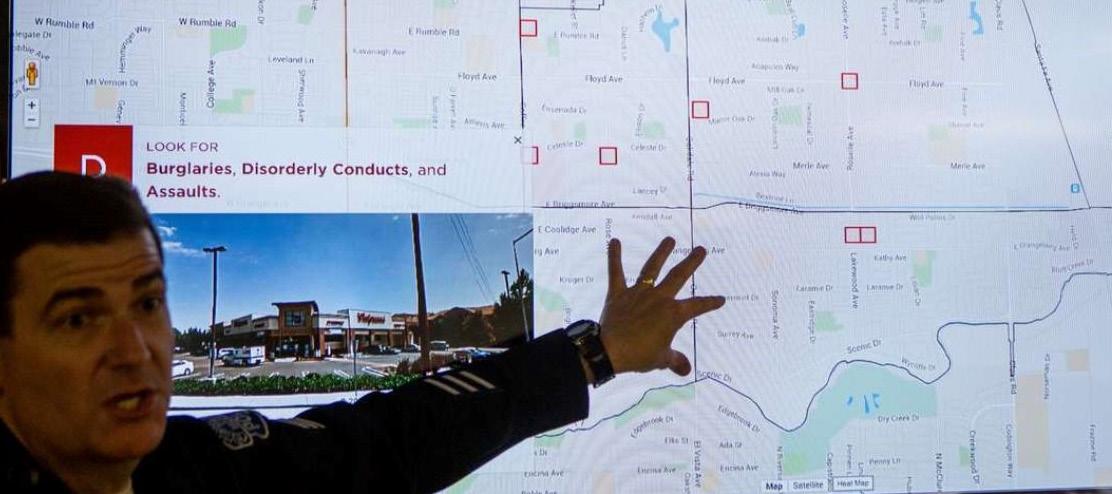
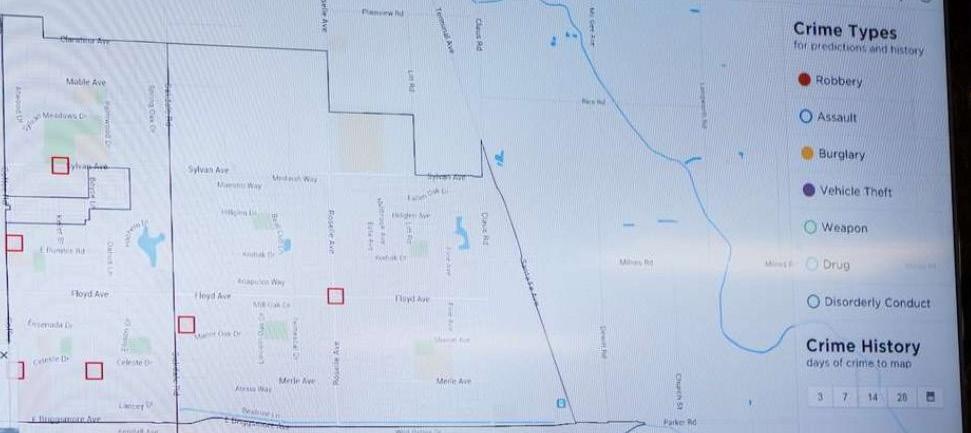
Yet, the technology has also given rise to much debate and controversy (especially over ethical aspects). These grew to the point that the city of Los Angeles announced it would terminate its collaboration with the start-up31. Indeed, the algorithm developed by Predpol tended to constantly target and send police patrols to Latino and AfricanAmerican neighbourhoods. The technological procedure thus brought about social tensions, triggered protest movements and created a climate of mistrust towards the local authorities.
The case of Los Angeles is enlightening in that it shows how security technology can, paradoxically, engender conflict and unrest. If it is to contribute to assuaging a territory, technology cannot be limited to surveillance. It must also enrich collective living, respect the social contract and, above all, be transparent (explainable and explained).
31. Although the official argument is budgetary
ASSUAGING THE PEDESTRIAN AND MOTORIST POPULATIONS WITH AI

In Sant Cugat del Valles (Barcelona province), Citelum has installed a system of intelligent street lamps that respond to ambient noise with light signals. The idea here is to alert city dwellers to their noise levels and in so doing encourage them to adopt self-regulating behaviours. This subsidiary of EDF is also working on a traffic management system capable of detecting dangerous traffic situations: traffic moving in the wrong direction, vehicle stopped on the roadside, low visibility conditions, etc. In this context, AI is used to characterise the level of visibility or obstruction of traffic lanes and to flash or intensify ambient light to avoid accidents. Nudge rationale is therefore used to “educate” motorists and encourage them to be good citizens. Being better protected during their journeys, they also ensure the safety of other road users, in a virtuous circle that concretely contributes to building an assuaged city.
AI TO HELP CITIES AGAINST CYBER ATTACKS

THE INCLUSIVE CITY

THE INCLUSIVE CITY: EXECUTIVE SUMMARY
The inclusive city is a city for all. A city that takes care of fragile and vulnerable populations A city where diversity rubs shoulders with diversity and where otherness thrives... But can AI contribute to the emergence of such a city?
This question is all the more justified as AI can be biased and a vector of discrimination. When poorly trained, algorithms can become racist, misogynistic or anti-Semitic. Yet such a phenomenon can have terrible repercussions in an urban context. Intelligent systems (autonomous cars, delivery drones, cleaning robots, etc.) unable to recognise certain populations endanger the lives of individuals. Furthermore, as we observed earlier32, biased data analysis platforms result in discriminatory solutions that carry stereotypes further. Before they are deployed in the city, or used as a tool for decisionmaking, these AIs must therefore be, at the very least, inclusive.
But the use of this technology in an urban context can lead to other forms of discrimination as well. Take the example of Data Mining. As we observed earlier33, mobile data analysis opens the door to augmented urban planning. But what about those who do not have smartphones (primarily the elderly)? What happens to these “non-referenced” uses?
They are (virtually) non-existent and invisible. Land use planning informed only by the insights of Data Mining thus leaves an entire swathe of our population unrecognised (a statement that is just as true of Web Mining). The augmented city thus operates according to a new standard: that of connectivity.
To prevent this from happening, it is crucial that this technology be hybridised with other methods (in this instance, with the administration of telephone questionnaires and/or field surveys). More generally speaking, the representativeness and relevance of the data gathered should be subject to questioning. Do likes or 280-character messages really lay bare citizens” profound aspirations? Are they enough to structure a land development plan? The growing place of the Internet and cybernetics in our cities will not be an opportunity unless our digital spaces (and technology in general) become representative of what we are.
32. See the example of Predpol in the chapter “Protective City”.
33. See the chapter “Living Cities” with the example of Cityscope.
ENCOUNTER
Arianna Salazar Miranda
Student at MIT
In her thesis The Shape of Segregation: The Role of Urban Form In Immigrant Assimilation, Arianna Salazar Miranda (PhD Student in Urban Information Systems at MIT) wanted to determine whether certain buildings, by their very configuration, fostered the integration of immigrants in Barcelona between 1998 and 2008. She started out by using machine learning to analyse and group Barcelona buildings based on their architecture. She then calculated a segregation dissimilarity index, by building type – and noticed significant differences between the indices. This means that some architecture types can mediate the residential segregation among different ethnic groups.
Arianna Salazar Miranda”s work is original in that it does not focus on a function (study, sleep, care, etc.34) but on a value (cultural openness). The cities of the 20th century were built on the idea that “form follows function”. This principle has led to the creation of fragmented cities. The urban space has become a mosaic, a place of separation. On the one side, there are districts for working, on the other there are areas for living, and elsewhere there are infrastructures for “culture”. This model is inherently non-urban35 . The functionalist city is set in stone and programmed for obsolescence, when it should be subversive and polymorphous. A city should accommodate existing uses and make possible those which have not yet come about. Only then can it become a city that has its place in the course of time.

In your thesis, you studied the relationship between segregation and the built environment. What was the results of your research ?
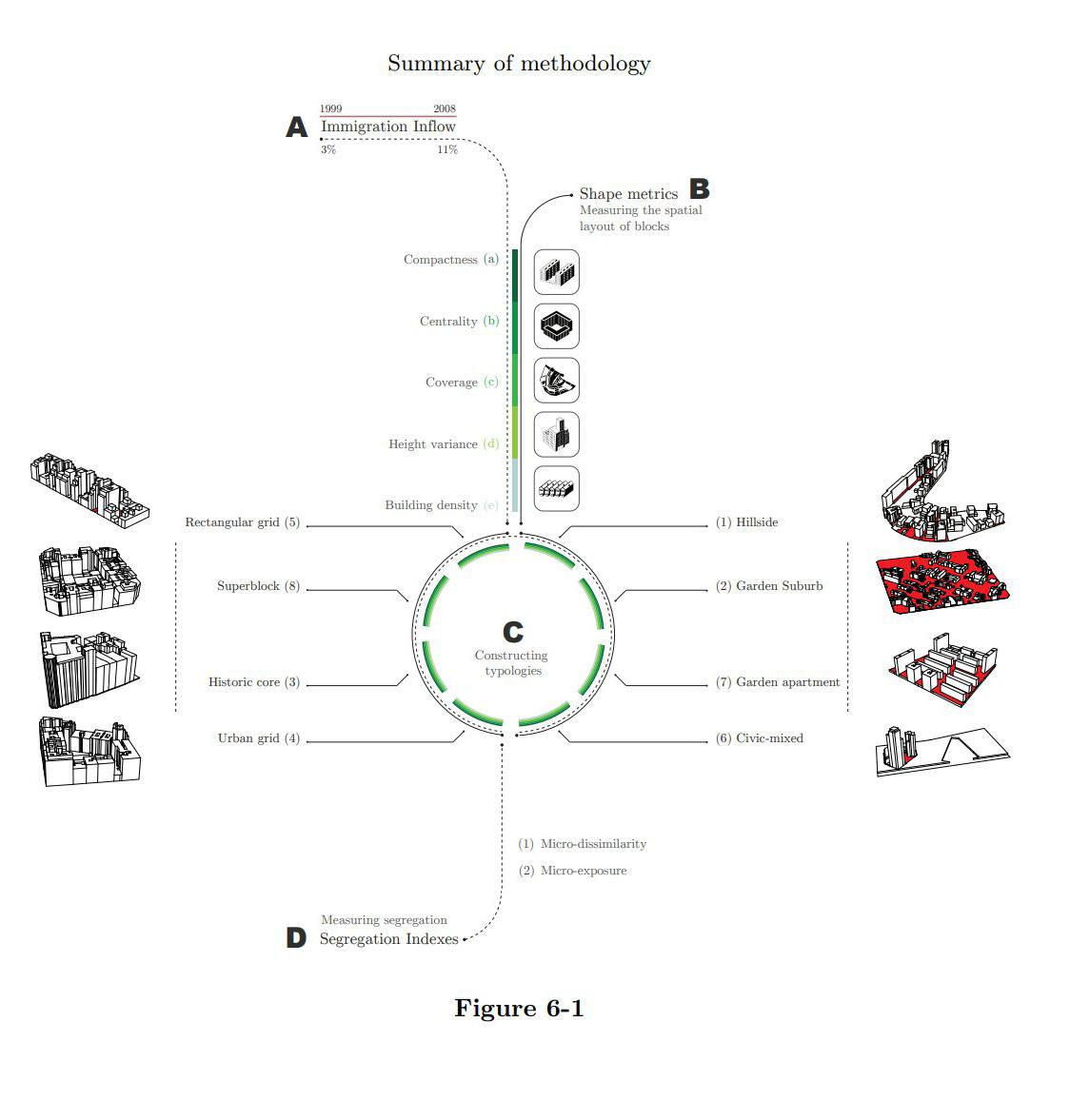
That project started a couple of years ago, and I”m actually reworking on it, or rather extending it. Segregation is usually analyzed at the state or city level. In my case, I had data on every person at the building level. Thus, it was super granular and I was looking to see how the configuration of the built environment [like a plaza, the height of buildings] affects how natives and immigrants coexist with one another. And I found actually that some typologies are better than others.
Spain, and especially Barcelona, had a very intense and short period immigration episode in 2008. And I found that typologies that have more central open spaces for example are better for assimilation. So buildings which have open spaces in the center of the block segregate less than buildings with open spaces peripherally.
Does it mean that Cities could use your works to better design some buildings and decrease segregation ?
It”s an interesting avenu to explore further and I think the results are promising. Though, I”ve only done it in Barcelona. So for now, I can only be confident for this city because what works in Barcelona is not necessarily transferable to New York. Furthermore, Barcelona has a very distinctive architectural styles. This facilitates for the learning of the patterns and for typologies classification. But I can imagine a future where we have sort of these measurements for many cities. Then we could learn from like different patterns, differents cities and try to find the optimal configuration.
To learn more, here is an article published in Cities.
FOCUS In Montreal, inclusive AIs serving citizens
In May 2019, the city of Montréal came into the spotlight when it won Canada”s Smart Cities Challenge. The Quebec metropolis won a $50 million prize that will enable it to create and deploy its own AI, alongside other projects. In this context, how does one of Canada”s smartest cities want to use this technology for the benefit of its inhabitants? A conversation with Martin Guy-Richard (Director of Business Intelligence for the City of Montreal) and Véronique Dufort (Head of the Open Data Team).
OPEN AND ETHICAL DATA...
The City of Montreal has an open data portal on which nearly 330 data sets are available (the ultimate goal being to integrate all the city”s data into it). Users can thus consult information on crime, the environment and the city”s infrastructures. “In the beginning, we did it [opened up that data] in a spirit of transparency. Now we also want to open up data strategically. In other words, we are thinking about the fields of application made possible by these data (open with purpose)” (V.D). These open data have enabled start-ups such as Transit (mobility aggregator) and Local Logic (real estate data analysis) to train their algorithms and refine their AI. It is also interesting to note that the City of Montreal is itself a user of the portal: “The City of Montréal is made up of 19 boroughs. Given this complexity, the portal is also a means of improving our organisational efficiency”. This tool has thus enabled the City of Montreal to function less in silo (a criticism often levelled at public institutions) and to move towards more cross-disciplinary governance. “By the force of circumstance, we have become a team that has an overall vision of the City of Montréal”. (V.D).

In addition to centralising existing data, the city is also working to create new data. It is in this spirit that the city of Montréal, each years, makes the app Montréal Trajet available to its inhabitants. For one month (from mid-September to mid-October), the application anonymously records the journeys of its users (when the latter have given their consent). Using this material, the city authorities can analyse how Montrealers make use of the space around them and determine whether the infrastructures are adapted to people”s practices.
jams. We want to use computer vision [image recognition] to automatically detect these obstructions and be able to offer Montrealers an alternative route” (Martin GuyRichard).

That being as it may, the opening of data should not go against the safety and well-being of the citizens. “It is not enough to have transparent data. It also has be be ethical” (V.D). In other words, the data portal must not disclose personal details about Montrealers (an individual”s address) or provide information that could endanger the city (preparation time for a fire station). In collaboration with other players, the City of Montréal is thus working on a charter designed to provide a better framework for digital data.
...FOR AI THAT SERVES CITIZENS
For more than 4 years, the City of Montreal has had its own AI unit (for Business Intelligence and Artificial Intelligence), a growing team of 18 people. In this manner, the City wishes to create smart systems to improve the daily lives of its citizens. It plans, in particular, to develop AI to detect unforeseen obstacles: “When construction work is in progress, the authorities provide for re-routing. However, it sometimes happens that vehicles obstruct these diversions. This quickly builds into heavy traffic
The obstacle detection project is actually part of a longterm strategy. The City of Montreal has thus identified 13 priority projects on which it wishes to deploy AI over the next five years. These include projects dealing with the analysis of crowd movements (detection of anomalies, indisposition, violence, etc.), automatic transcription (to optimise the functioning of emergency call centres) and automatic recognition for city archives.
To take on these projects, the city intends to proceed in an ecosystemic manner. Since September 2019, it has had a laboratory at the MILA (Institut Québécois d”Intelligence Artificielle). Through this partnership, it is
able to benefit from the AI expertise of one of the largest Machine Learning centres in the world. Being established in a hotbed of innovation is also an opportunity to exchange ideas and develop synergies with major players in the field of technology (Samsung, Microsoft, Element AI, etc.). In addition, the City of Montreal intends to work with the CRIM (Centre de Recherche Informatique de Montréal), one of the foremost applied research centres specialised in IT in Canada.
WHAT LESSONS DOES THE MONTREAL MODEL OFFER?
The determination to mobilise collective intelligence around AI is characteristic of Quebec”s DNA. As Monique Savoie (Director and Co-Founder of the Société des Arts Technologiques) told me: “Quebec is a bit like a survival laboratory. The culture of oral transmission and networking is very strong here”. In Quebec, collective intelligence (and AI) are meant to be, very concretely, at the citizens” service.
However, not every city has the financial wherewithal and technological maturity needed to develop their own AI. In this respect, and as the example of Montreal shows, local institutions can keep hold over decision-making power by implementing a well thought-out open data policy, rather than one by default.
URBAN GEMS
AI AGAINST GENTRIFICATION
In London, CASA has created QUANT, an algorithm capable of simulating the redistribution of a population across a territory in the wake of an economic event (job creations, dismissals, etc.), the creation of new infrastructures (rail stations, roads, etc.) or, over the longer term, shifts in population. By analysing the city”s mobility system and land policy using Machine Learning, QUANT can alert to developments as they emerge, including gentrification.
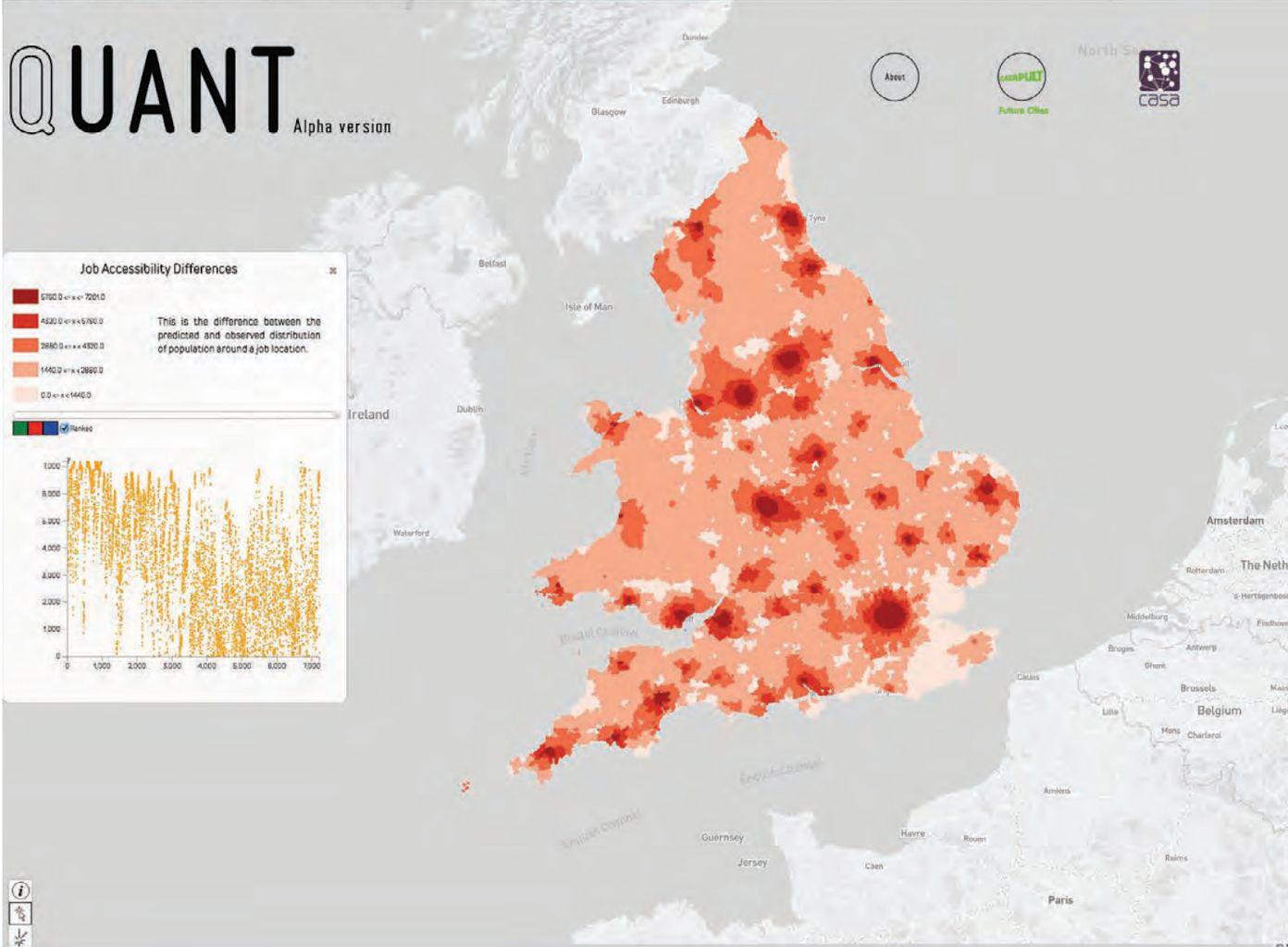
AI FOR INCLUSIVE PLANNING
In the Netherlands, the start-up Cyclomedia has developed a 3D immersive view solution. It draws on multiple types of sensors (including LIDAR) to build a digital twin of the city. A town planner, a town hall or a company can thus view how the city responds to a newlyimplemented development in the urban environment. In particular, this technology can be used to automate the identification of spaces that are not suitable for the mobilityimpaired (sidewalks that are too high, squares that are not wide enough, etc.) and simulate post-development reality. The resulting data can then serve as a medium to estimate the time and cost required to create more-inclusive neighbourhoods.

Muhamma Yunus,

5. CITIES AND GENDER
Cities have all too often been built by men for men. One consequence of is the existence of gender-specific uses of public space. As we noted in our previous publication: “men occupy the public space, whereas women cross through it”. The reasons for this lie in security factors, but also in cultural and urban factors. So can AI act on these factors and contribute to bringing balance back to our cities? Before answering that question, we should note that AI itself crystallises a number of gender inequalities. Whether through the imaginary world around it, the way it is designed or the stereotypes it carries, AI remains a male technology. This being so, how could a male technology serve women and the female cause? It is precisely in an attempt to answer this question that I went to meet Laurence Devillers.

ENCOUNTER
Laurence Devillers professor
Laurence Devillers is a Professor of Artificial Intelligence at Sorbonne Université, and is carrying out research at the LIMSI/CNRS where, since 2004, she has been coordinating a team working on the affective and social dimensions in spoken interactions”.

What is the representation of women in robotics and artificial intelligence? How and to what extent does this representation harm their image and, thereby, our society as a whole?
The systems we use in artificial intelligence are increasingly widespread in society and in our cities, and can become vectors for reinforcing stereotypes, in particular gender stereotypes. There is an urgent need for awareness about these biases, for both women and men. Artificial intelligence systems collect data for Machine Learning, then models are generated from the resulting Big Data. Yet these data can be gender-discriminatory. For example, the robots serving as female sales agents during voice chats do not represent the diversity of society, as their voices are mostly those of young women. When you look more closely at what is going on, you find that 80% of the coders of these objects are men and 80% of the agents built are feminised. They include assistants, avatar agents, or sexual robots which reinforce stereotypes and the representation of dominant models, and therefore a form of alienation of women. Developers take care to ask their clients whether they would rather have a female or male voice. And as it happens, both sexes come out in favour of women”s voices, which are perceived as gentler, more maternal, and more cheerful. As a consequence, the world of the future, where our interactions with more or less personified voice-controlled machines will become more frequent, could well lead us towards biased gender perceptions that amplify stereotypes. Concurrently, the personification of machines creates another dilemma. Machines are personified by their
creators to facilitate interaction with them, and the human speaking to them naturally tends to anthropomorphise them.
The representation of women through these objects must be watched carefully, in the same way as that of the man, who becomes just as much a caricature, as he mirrors her behaviour. What are some of the possible solutions that might counter these issues? Should we agree that 50% of the voices should be male and the other 50% female? Should we impose a male voice or female voice, at random?
A solution governed purely by chance appears essential. When you call a department at a company today, you don”t know whether the person responding will be a man or a woman.
What can we do to ensure that there are more female developers and therefore naturally fewer algorithmic biases?
I think we need to introduce computer science as an applied creative solution. We should attract more young women by emphasising the ethical and eco-responsible aspect of these professions. Bringing responsibility into the design of machines ushers more humanity and values into a cold, mathematical and computerised world. The topic will be of interest to both men and women.
How can artificial intelligence help us to fight gender inequalities?
We also need to beware of profession-related stereotypes. Often, in the collective imagination, doctors are men, while nurses are women. Recently, the advertising industry”s Ethics Committee picked up on a problem stemming from these representations in an advertising production. To illustrate an engineering degree course, the campaign had chosen a young, stylishly-dressed man carrying an attaché-case, followed by a young man in jeans with a backpack to present university studies, and lastly, a young woman, to embody the medical and care professions. So long as our representations remain locked in those images, stereotypes and discrimination will live on.
In much the same way as it is interesting to measure air or water quality or the breakdown in energy sources for our environment, artificial intelligence makes it possible to measure behaviour in society and is a factor for understanding collective intelligence. It can quantify, for instance, the number of women who speak out in front of the media to give their opinion. And it is often demonstrated in sociological studies, that when there is a gender-balanced group discussing a subject, added value emerges: in the number of ideas deployed, and the breadth of the possibilities. As soon as this awareness grows and we learn how to make it visible, we will be able to create projects around social living in the city, where the two sexes co-exist.
Could you describe one of these solutions in more detail and explain how they can bring about greater harmony?
When we carry out speech recognition, we need a body of audio data to teach the model to recognise sounds, words and semantic phrases, and to study how we pace our speech. Researchers distinguish between situations in which we interact with someone and those in which we talk without interaction, such as a journalistic conversation. When I asked them why they had not also carried out these experiments on women”s voices, they replied that there was no corpus and that the study was thus more complex. If women speak out in the media less than men and are less frequently invited to give their opinion, we will have less data on their voices and any speech recognition models that we might build from them will be less effective.

To turn this situation around, we need to observe the data and ensure that we have categories that are sufficiently represented, such as certain accents from different cultures. We see the shortcomings that arise when systems with insufficient data are asked to study voice inflections (people”s pronunciation, the variability of their speech, their degree of confidence) for recruitment purposes. If fewer women were recruited up to that point to fill the functions or objectives of the recruitment process, the result will inevitably be biased. The same will be true for someone with a foreign or original accent.
After the measurements made from the corpus used for modelling, we need to carry out benchmarking and establish a perimeter of variability around what we are modelling in order to study how the system responds. We are not looking for weak signals, but for strong elements that we are working to strengthen.
URBAN GEMS
TRANSPORT FOR ALL
How can we create more inclusive transport? It was with the aim of answering this question and take up this challenge that the Diamond Consortium was founded. Made up of 14 international public and private mobility players, Diamond”s aspiration is to fight inequalities between men and women in the field of transport, based on a focus on 4 use cases: railway and metro infrastructures, self-driving vehicles, self-service bicycle rental systems and employability in the transport sector. It is towards this end that Diamond collects and analyses multiple types of data to study the factors conditioning the user experience in transport as well as employability in this sector. Diamond”s first task was to construct a definition of inclusiveness (based on administered
questionnaires, semantic analysis of social networks, behavioural data analysis, etc.) according to their use case. This definition will then be used as a foundation for creating a “ toolbox ” that public and private actors will be able to use to measure the inclusiveness of a transport infrastructure or transport.
In Europe, 78% of people working in the transport sector are men. This imbalance too often leads to the creation of non-inclusive transport infrastructures and vehicles. Through its research and data collection activities, Diamond is dedicated to creating ethical transport networks that work to everyone”s benefit.

OPENING JOBS TO WOMEN THROUGH AI
Textio, a smart text editor based in the United States, used AI to explain a correlation between the gender of job applicants and their job descriptions. Using Machine Learning, the start-up was able to demonstrate that some words are “masculine” where others are “feminine”. For example, the phrase “managing a team” on a job description tends to attract mainly men, while the phrase “developing a team” attracts primarily women. On average, the description of a job filled by a man contains twice as many masculine phrases as feminine ones. Textio works with its clients to overcome this problem by creating more inclusive job descriptions with a less gendered and more balanced lexicon. Atlassian, the start-up”s client software publisher, has notably multiplied by a factor of 5 the number of women recruited using this technique.
6. THE CITIZEN CITY
Over the last decade, CivicTech (or GovTech) players have established themselves as major players in urban innova tion. They use digital and new technologies to augment cit izens and our democratic systems. This technological con stellation is characterised by several use cases including the digitisation of administrative processes, the creation of chatbots to inform inhabitants and the deployment of par ticipative platforms. However, due to its opacity and cen tralised mode of operation, AI can also represent a threat to our individual liberties and our community living. Inte grating AI into CivicTech solutions will not be enough to turn the city (back) into an agora, where “everyone flocks to the assemblies”36. The AI itself will need to be demo cratic.

THE CITIZEN CITY: EXECUTIVE SUMMARY
The digital age has often been likened with feudal times. Gaspard Koenig, for instance, wrote in The End of the Individual:
“To understand the digital spoliation of which we are victims today, we need only read George Duby”s writings on the economy of the Middle Ages. At the start of the previous millennium, the serfs in their clods delivered the bulk of their production to their lords in exchange for more or less real “free services”: protection against war or the use of village facilities”.
Like a serf, modern man appears to have bartered his freedom and privacy off for “free services” (the ability to interact with friends, find a way through the city, or watch videos). So how can we do away with this digital serfdom? Technology can help us start answering that question. In its current conception, AI functions as a centralised, close-off entity. The algorithms gather and analyse user data. In addition to being energy-intensive, this model is, by essence, intrusive. That being said, there are alternative learning methods that are more respectful of individual privacy. One example is Federated Learning. This is an “edge”, decentralised technique where information systems share the results of their learning, rather than the personal data themselves. The result is a decentralised “small data”37 system (Luc Julia) that preserves the privacy of citizens.
Additionally, the issues in data governance have eminently political implications. Regulating AI and digital technology implies creating a contract of trust between its stakeholders and the citizens. In order to keep the web, and ultimately our “smart cities”, from becoming a space of discord, we need to rethink the social contract -- and extend it to the virtual world. To this end, the City of Montreal has co-authored with its citizens a digital charter that regulates the use of data in the public space. The charter guarantees
fundamental principles (digital sovereignty, right to experiment, guarantee of human rights, etc.) which the city commits to honour. The Go Boston 2030 project is another example of such an approach. Here, the City, citizens, businesses and academic centres have come together and coordinated to define a common political project around autonomous mobility.
But the problem of digital serfdom is also a legal one. It is because citizens are dispossessed of a digital identity that they fall victim to this digital spoliation. To counter this problem, Alex Pentland calls, in his New Deal on data, for “private ownership of data”. This would enable citizens to be both masters and owners of their personal information. In other words, they could 1) store their data anonymously in a space that belongs to them, 2) distribute or sell them (on a data market) and have a say in how they are used, 3) be able, at any time, to withdraw them from use that they consider inappropriate and/or delete them. In such an environment, platforms can be created to centralise and exchange personal data. On an urban scale, similar solutions are being developed by multiple cities, including Dubai and Sejong.
The formation of a digital identity, the development of “privacy by design” algorithms and the creation of a social contract around AI are therefore the three prerequisites for the emergence of a democratic AI. Only then will this technology be able to serve our freedoms and enrich our citizenship.
Gaspard Koenig
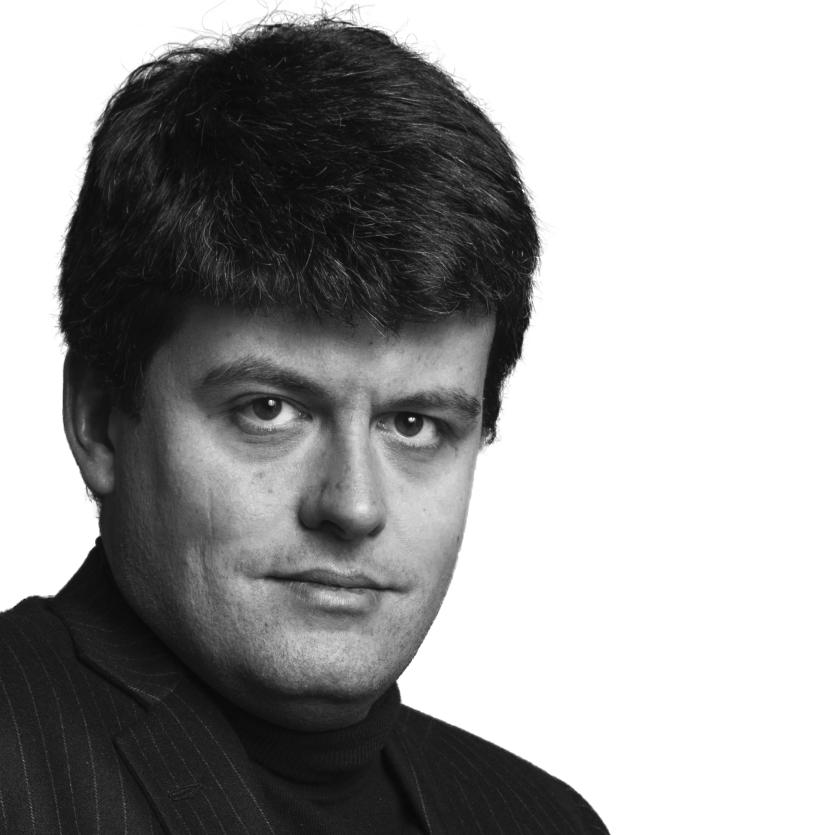 Philisopher
Philisopher
Philosopher, essayist and president of the Think Tank GenerationLibre, Gaspard Koenig has embarked on a journey to the heart of artificial intelligence! In his latest book, The End of the Individual, he explores both the promises and the risks which this technology entails.
In your latest work, The End of the Individual, you note that the values of Confucianism are a perfect match for the characteristics of AI. Which is not the case of Western culture. Does this mean that we are condemned to trail behind China when it comes to AI?
The United States has been ahead on the foundational research and in developing the technology. China, as Kai-Fu Lee has said, is in the age of implementation. In this age of implementation, it is the amount of data available as well as the ability to extensively deploy these AI technologies that matters. On this count, China would appear to have no taboos or restrictions. As far as we are concerned, it is hard to see how our regulations, which are justified on other grounds, would not impact AI research. Because of these restrictions, we are depriving ourselves not only of tools but also of databases and therefore of the capacity for improvement. In China, AI is in line with the society”s culture and aspirations. The technology thus enjoys widespread enthusiasm.
What I am interested in is whether an alternative model can emerge, using the technology less effectively but in a way that is more respectful of our private lives, or whether, little by little, the Chinese model will prevail.
In Los Angeles you met with activists who are fighting against predictive policing. What is your view on PredPol?

I was not able to meet with the Los Angeles Police Department. As a result, I heard only one opinion. What can definitely be said is that the opinion I heard is extreme, and that it does not offer any solutions, aside from withdrawing from the world. The question of predictive policing refers to the eternal dilemma between efficiency and freedom. If this technology makes it possible for police officers to carry out better patrols and fight crimes more effectively, it becomes complicated to be completely against it. That said, it is crucial to understand the data connections on which these systems are based. Citizens must have the right to control their data. Even if this results in sub-optimal algorithms and makes predictive policing less effective.
You are proposing to give individuals the chance to be the masters of their data and to gain a form of digital autonomy. Are you not afraid that people will prefer well-being to freedom?
The solution that I propose gives everyone the opportunity to make this choice. Whoever prefers well-being will be able to accept the nudge and provide their data. Those who want to remain “free”, will also be able to protect their data, in exchange for financial compensation. Between the two, a range of differentiated choices will naturally emerge. Some people will choose to hand over their data for e-commerce but not to share their geolocation. Others will refuse to provide their data to the pharmaceutical industry but agree to help medical research. If a collective decision emerges, it will emerge in spontaneous order, depending on the choices which millions of individuals will have made. In this social balance, those who want to live highly protected will still be able to do so. This will make them free-riders, in a sense, benefiting from advances to which
they have not contributed. However, there have always been free-riders. We all benefit from blood bags when we don”t all give blood. Despite this, I prefer to protect these free-riders. They form those grey areas that make society sub-optimal but allow for error, divergence, trial and error, and therefore progress.
You notice that behind your computer you can thwart AI. In an urban environment, this looks much more complicated to do...
Such offuscation strategies are not a structural solution. They are deployed by an activist minority. I am certain that these same activists will develop solutions to escape the eye of AI in the city. This is already happening in Hong Kong, where demonstrators have created stickers to fool surveillance cameras. These systems will undoubtedly improve and, in turn, thwart any resistance... In Minority Report, John Anderton (the main character) has his eyes transplanted to foil retinal recognition. This is obviously an extreme example, but one that shows there is always a way to fool the system.
Related to the topic you are asking about is the question of regulations. In Smart Cities, will it be mandatory for citizens to use self-driving vehicles? 100 km from Beijing, Xi Jinping is trying to build, from the ground up, a Smart City for autonomous cars only. There, the question of whether people will be allowed to drive non-connected will become a question of public policy. From my perspective, it is important to be able to drive around a city without having to say where you are going, and in a car that belongs to you.
We are seeing the emergence, particularly in China, of “autonomouscar-centred” cities. The 20th century has been criticised for producing self-centred cities. Are we not repeating the mistakes of the past?
Technology should help us as we build our lives, not the other way around. That is what I witnessed in the autonomous ports in China. Ports are marvellous living places that have been celebrated for centuries. When it comes to autonomous ports, though, not only are there no humans, but if there were a human, malfunctions would arise. By the same logic, cities are being built, for example in China, which are absolutely dreadful. Incidentally, when on holiday, the Chinese don”t go to visit Hangzhou but come to Paris and take pictures, marvelling at the Marais and the Boulevard Haussmann. The beauty which they see and recognise as human beings is a beauty that has been built up in spontaneous order over centuries. If AI had been used to build Paris, there wouldn”t be a single tourist in the streets. What is being built in China today does not take into account basic anthropological needs. By taking that route, they run the risk of transforming human beings into machines instead of allowing them to flourish thanks to the machine.
URBAN GEM
AI AS A MEDIUM FOR USE-BASED URBAN PLANNING

Brushing the dust off the world of consultations to make them more effective and relevant: this is a promising avenue for putting AI to work for our well-being and our democracies. The example of the consultation process is apt: a participatory process, it consists of surveying the users of a space in the street to hear their opinions and make planning decisions aligned with residents” feelings and expectations. In France, the start-up company Qucit has taken up the challenge and is now processing survey data with AI.
It has developed Qucit Comfort, a digital consultation tool that uses multiple AI techniques to involve the user in the making of cities. For this, users of outdoor spaces are surveyed in the field for a week and each survey is geolocated and time-stamped. Depending on the study being carried out, questions may deal with accessibility, the sense of security offered or the auditory experience of a space. Qucit Comfort then uses artificial intelligence algorithms to process this survey data and model user perception at each point in the territory. Cross-referencing these data, it is able to create a map of perceptions where the urban experience is territorialised and characterised. The satisfactory areas and those needing redevelopment stand out clearly and, using the expectations gathered, planners can build a targeted action plan. This technique opens the door to an use-based urban planning, in step with the citizens and their aspirations. Qucit Comfort has already been deployed in Paris, New York and Bordeaux.
In Singapore, the Zurich ETH has developed Ideas for Tanjong Pagar software, in reference to the name of a Singapore port that was on the verge of being relocated. Available online, it enables citizens to sketch out their ideal neighbourhood, like in SimCity. They can add sports facilities, increase (or decrease) the size of buildings or add greenery as they like. The data collected are then analysed in order to bring out patterns and to identify citizens” aspirations in land use planning: What does their ideal city look like? How do they wish to take possession of the space? Ideas for Tanjong Pagar makes it possible to ask citizens about these issues and, above all, integrate their responses into the urban planning of the future.

PRESERVING INDIVIDUAL LIBERTIES THANKS TO COMPUTER VISION
In France, the city of Dijon has developed an AI application to automatically blur, on surveillance screens, the faces of individuals found on private property. The idea here is to safeguard the privacy of citizens and their fundamental rights by using non-intrusive cameras. This use case is particularly interesting because it reminds us that AI is not, in itself, anti-democratic38. While this technology can serve totalitarian interests and create surveillance cities, it also has the potential to protect and strengthen our individual freedoms.
7. THE ECOLOGICAL CITY
Cities occupy 2% of the planet but account for 70% of our CO2 emissions. Within this context, AI can (and must) contribute to the creation of low-carbon cities -- in other words, cities that use predominantly renewable energies and that operate on the principle of circularity. However, the ecological city is also a green city where biodiversity flourishes. This biodiversity has many virtues for our ter ritories, our society and our health. It softens manners, refreshes cities and contributes to their resilience. In this context, and as we will see, AI can be used as a medium for the development and operation of sustainable solutions that are respectful of life and living things.
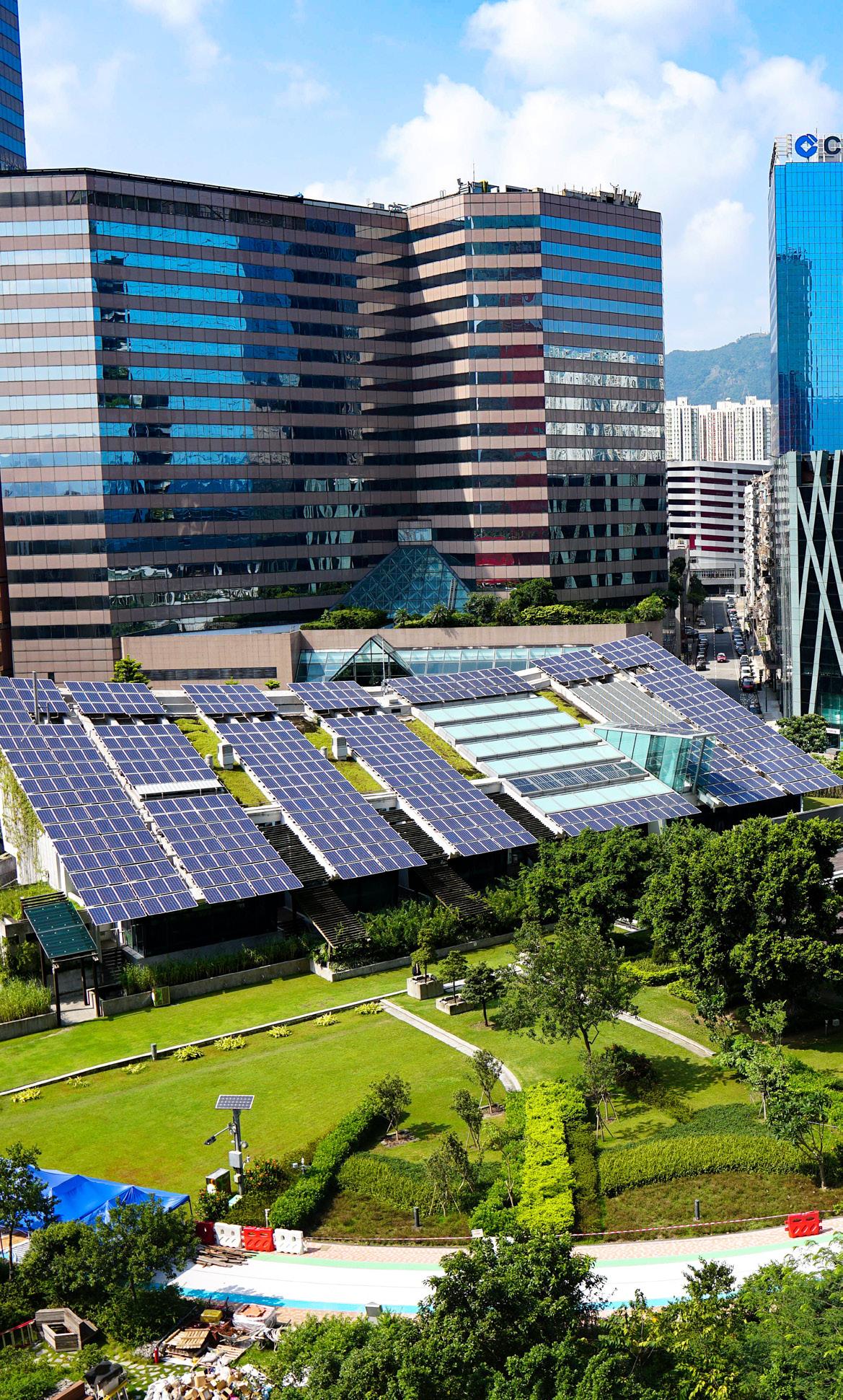
ENCOUNTER
Yoshua Bengio
Professor
Yoshua Bengio is one of the world”s leading experts in the field of artificial intelligence and a pioneer in deep learning.
Since 1993, he has been a professor at the Department of Computer Science and Operations Research at the Université de Montréal. Co-director of CIFAR”s programme Apprentissage automatique, apprentissage biologique, he is also the founder and scientific director of Mila, the Institut québécois d”intelligence artificielle, the largest university research group in deep learning in the world.
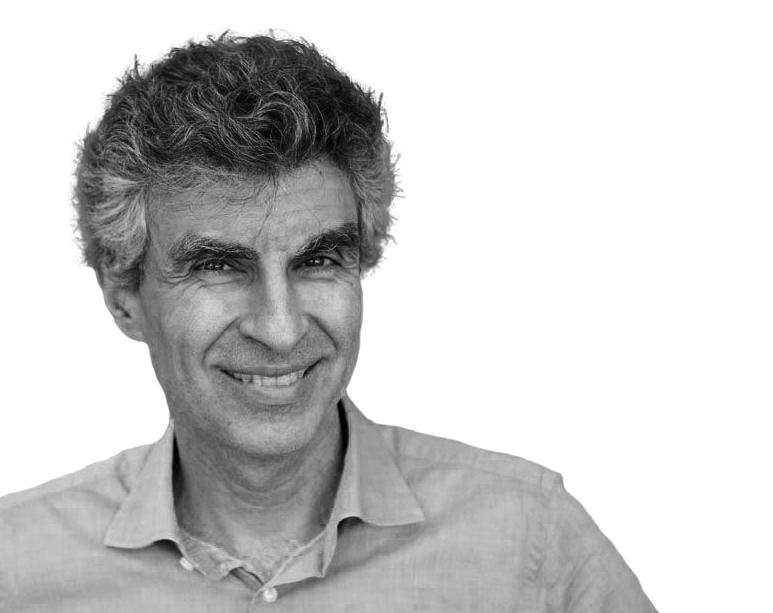
You explain that one of the next objectives is to achieve human-level AI. What does that mean? And what are the obstacles keeping us from doing so?
How could AI help us face the climate emergency?

Achieving human-level AI is an approximate goal, as people can be very smart on some tasks and relatively dumb on others. This is true of humans, but even more so of today”s intelligent systems. Alpha Go, for example, only plays go, it can”t recognise faces, drive a car or produce machine translations. For each of these tasks we have systems that have been trained separately on specialised data. For the time being, we have systems that, in general, do not even reach a human being”s level of skill, with exceptions such as the game of go. We would therefore like these systems to reach a human”s level of skill on each of their tasks, but also overall, so that the same system has the capacity to understand the world as comprehensively as possible. And that is still a long way off. What is preventing us from doing so? These are questions that researchers are asking themselves. We obviously don”t have the answers, even though each researcher has a hunch. What is clear is that there are both material barriers (our brain is much more efficient in terms of computing power and neuronal connections than the artificial networks we are building today) but also algorithmic barriers (in terms of the mathematical methods behind these systems).
The algorithms already at our disposal can lend us a hand in this fight against global warming. For example, we have a project on modelling new materials. Learning algorithms can be used creatively, to invent new molecules. This is particularly valuable in dealing with climate change because new materials will be needed if we are to create more efficient batteries or to capture CO2 emissions. We have another project where, working in cooperation with climatologists, we are trying to better model climate changes themselves. There are all sorts of things which the current physical models are not capable of grasping, such as clouds or water flow (to predict floods). We are also working to use these climate models to be able to
predict whether a home will be flooded in 50 years, and if so, how that will look. The idea here is to raise awareness of global warming and make people become aware of how they will be affected by climate change. There are many other areas of application, for example to optimise an infrastructure”s energy consumption, to better spread the demand for electricity or to increase the share of renewable energies used by the electricity system.





One of the things you advocate for is responsible AI. What is responsible AI? And how do you, at Mila, make sure you are creating responsible AI?
It is not only AI that needs to be responsible. It is, above all, the humans deploying it. We are very far from creating AI that needs to be responsible, quite simply because we make highly-specialised applications that don”t (yet) need to understand human psychology. When we do get to that point, yes, we will need to build responsible AI that understands human morals and the values that humans can have. For the time being, what I and my colleagues are most worried about, in Montreal, are the ways in which these technologies will be used. AI can be used to do good, to save lives and to improve people”s well-being -- but it can also be used to take advantage of people and manipulate them, to make money at the expense of people”s health and the environment.
FOCUS AI for circular cities
AI can contribute to creating “circular cities”. In other words, cities that operate on the model of the circular economy (favouring recycling over linear creation, transforming waste into compost or energy, etc.). In London, the Centre for Advanced Spatial Analysis (CASA) has developed a bio-inspired algorithm to optimise industrial symbioses39. Industrial symbiosis occurs when an ecosystem of companies exchange waste flows among themselves and reuse them in accordance with their industrial activity. This is referred to as an eco-industrial park. The city of Kalundborg in Denmark is home to such a park. Today, nearly 30 exchanges of different kinds take place between its members, saving a total of 15 million dollars a year. In China, at the REDA eco-industrial park, construction factories have been able to benefit from 66,000 tonnes of fly ash that have been used as raw materials. The difficulty with industrial symbioses is that their formation requires prior classification work (to identify rejected and absorbable waste) and the implementation of a particularly efficient supply chain (to create waste flows at lower cost). It is precisely here that CASA has used AI to simulate multiple
configurations of eco-industrial parks (geographical positions, industrial clustering effects, transport costs, etc.) and identify those that maximise benefits between members. This model is all the more attractive as the principle of industrial symbiosis can potentially be applied to the urban system. In this new paradigm, the members would not be industrial players but companies and/or individuals. The French application Too Good to Go is already paving the way for such practices.
is interesting to observe that this concept is based on numerous biomimetic innovations. Industrial symbiosis, the anaerobic digestion of waste and its composting are all examples of phenomena inspired by organic processes. As if to remind us that our best ally in dealing with the climate emergency remains nature.
Organic waste is also a valuable source of energy. It can be used to create biogas through anaerobic digestion or to foster the growth of microalgae (which go on to produce biomass). In each of these cases, AI can be used to optimise these particularly complex processes. It makes it possible to predict the daily waste flow, to determine the best location for these production plants and to facilitate the integration of this energy source into smart grids40.
The “circular city” invites us to take a new look at our society and our consumption habits. In this respect, it
THE VIDEO
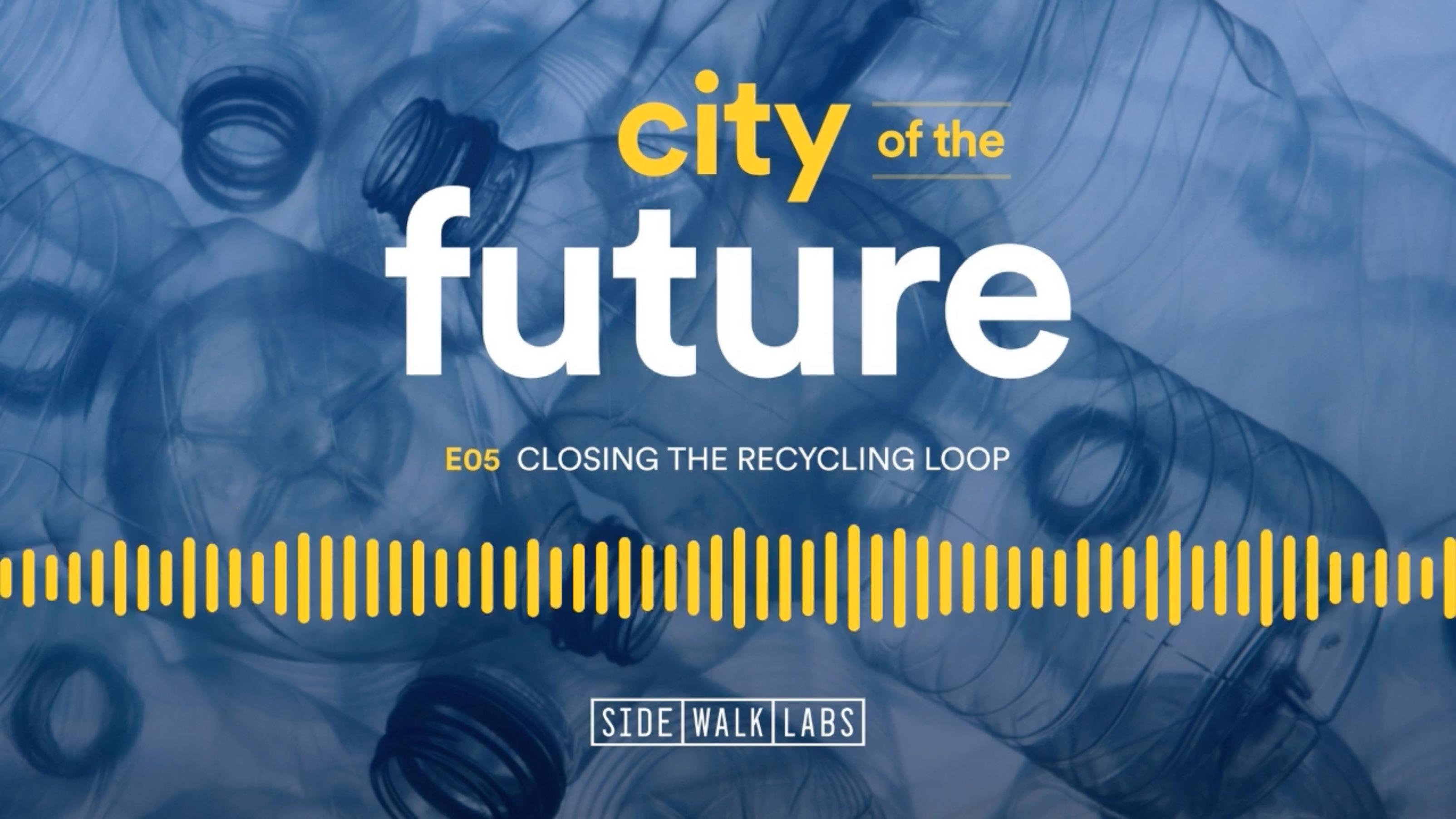
URBAN GEMS
USING AI TO PRESERVE URBAN BIODIVERSITY
In the United States, the start-up Descartes Labs is using Computer Vision on satellite images to automate tree counting in defined urban areas. This solution is all the more valuable as these estimates are complex and costly to carry out. Although particularly useful, satellite image counting does not give any indication of the “greenery perceived” by city dwellers. In other words, the ability of a space to satisfy individuals” biophilia. For instance, a neighbourhood may have many trees but offer little vegetation for its occupants to see. In this respect, the teams at MIT”s Senseable City Lab have developed a statistical method to quantify the proportion of vegetation in the urban landscape (by analysing images from Google Street View). This method was then used as a springboard to create a Green View Index on cities. With it, users can track the development of a canopy and measure “street greenery”.
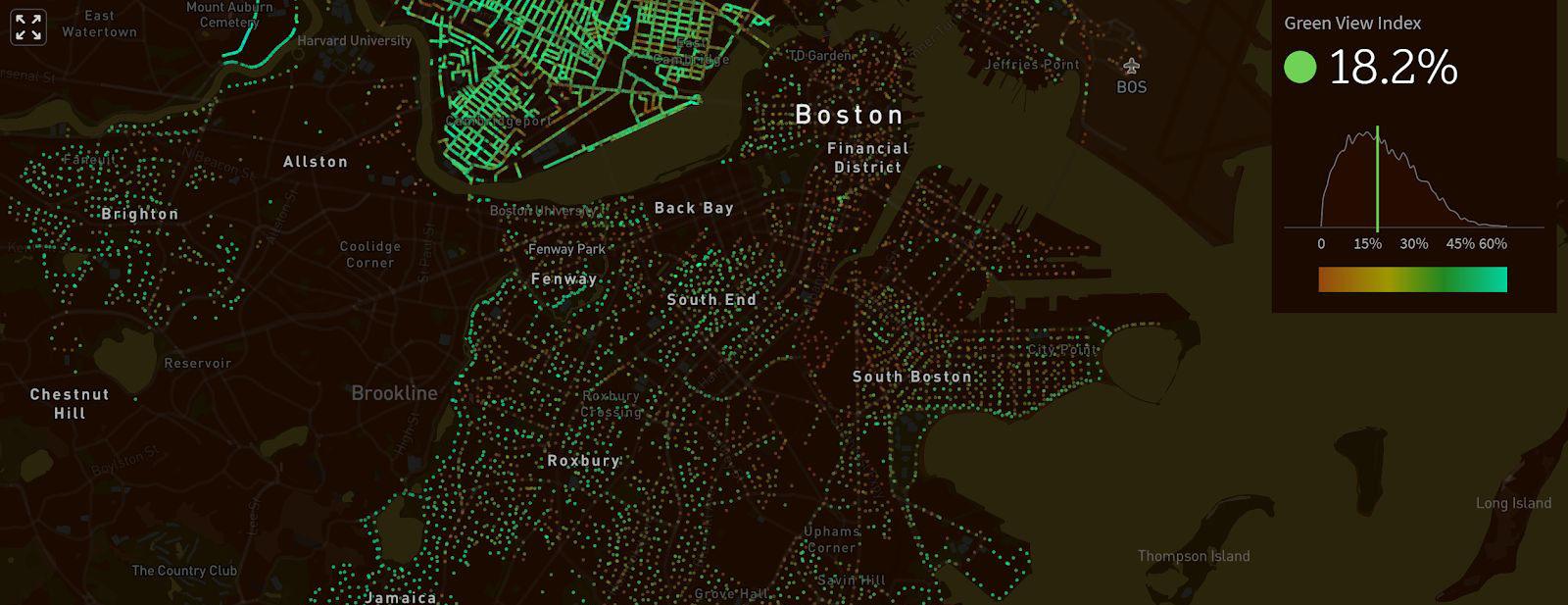
In London, researcher Alison Fairbrass (Postdoctoral Research Associate at UCL) uses Machine Learning on acoustic sensors to automatically identify bat ultrasounds. The technology is used for instance to map the influence of certain urban activities on the bat populations found at Elizabeth II Park and to monitor their development. This work is all the more significant as this mammal is at the top of its food chain. Consequently, the health (and possibly the behaviour) of several other animal species can be estimated, based on its evolution.
Source: http://www.batslondon.com/
OPTIMISING BUILDINGS” ENERGY CONSUMPTION
The French company Effipilot used AI on the Lucie Aubrac School (Roubaix) to optimise its HVAC (Heat, Ventilation and Air Conditioning) system. To do so, the Lille-based startup used machine learning to model the school”s energy performance and shift from a reactive model (changing temperature when thermal variations are felt) to a proactive model (anticipating thermal variations). Thanks to this solution, the building”s energy consumption has been reduced by 30% and the comfort of its users has increased significantly. On the strength of this success, the city of Roubaix has decided to apply the Effipilot solution to some thirty additional buildings and monuments. Such practices are particularly important as the buildings” energy consumption is responsible for almost one-third of our CO2 emissions.
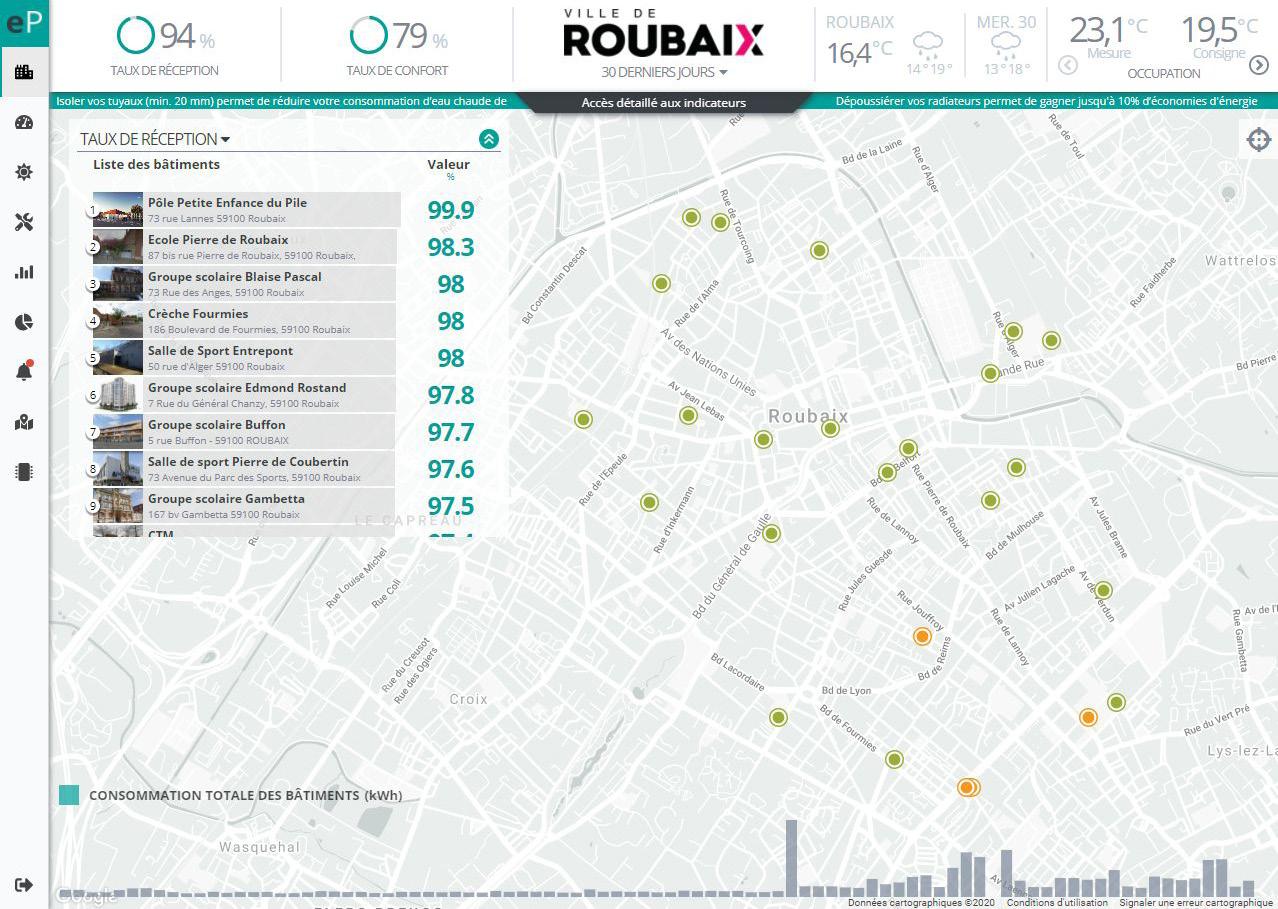

8. THE ACCESSIBLE CITY
AI can contribute to creating an appeased and sustainable mobility, in particular through autonomous mobility, urban data analysis platforms and MaaS (Mobility as a Service).
Each of these innovations can contribute to the creation of pedestrianised cities and make possible a balanced and low carbon transport mesh.

FOCUS AI for pedestrian cities
AI can contribute to creating pedestrian cities. In Boston, Andres Sevtsuk and Michael Mekonnen developed the Urban Network Analysis (UNA). UNA is an open-source algorithm that can be used to model a space”s pedestrian activity. For this purpose, UNA aggregates multiple data sets. They include the accessibility or “reach” of buildings (how many people want to enter a building), their closeness or their size, to name only a few examples. Each of these parameters provides information on the pedestrian flow it generates. By superimposing this information on the structure of a city (the size of its pavements, crossings, etc.), planners can measure its “walkability”. In other words, they can determine the extent to which a city lends itself to walking. For example, a neighbourhood with high reach but narrow sidewalks may cause “pedestrian congestion”. UNA can thus be used to assess a spatial planning project”s “pedestrian accessibility” and to contribute to the creation of “human-centric” cities.
pattern”41. The readability of a city determines part of our judgement of it. A “welcoming”, “warm” city is a one that is easy to read and which lends itself to wandering. A city”s readability comes from its uniqueness (its ability to be recognisable) as well as its “punctuation” (points of reference which enable people to find their way around in space). An excess of singularity results in an indecipherable city, while too much punctuation creates unreadable spaces. It is interesting to note that both these parameters can be measured using AI. The teams of the MIT Senseable City Lab have thus used AI to measure the singularity of cities as well as to quantify the readability of selected spaces. Other technologies can also be used to contribute to creating pedestrian cities. In London, the start-up Pavegen offers smart urban surfacing materials that analyse pedestrian flows and, to a limited extent, generates electricity from walkers” kinetic energy.
It is precisely because man roamed the world that he decided to build menhirs (the first architectural act if ever there was one). The menhir was the anchor of the first men. A landmark, a constant which, by its verticality, structured the evanescent horizon. It is by walking that we explore, map out and take ownership of a territory. In this sense, walking is as much a physical effort as a cognitive process. Walking gives us the chance to plunge into a “city”s unconscious”43, to go forth where chance might find us (“hacking technology”, as Saskia Sassen would say) and to read space. The pedestrian city is therefore, quite simply, a human city. And vice versa.
While AI can be used in the study of pedestrian flows, it can also be used to measure a city”s readability. In other words, “the ease with which parts of the urban landscape can be recognised and organised in a coherent
Why is it so important to create pedestrian-friendly cities?
First of all for health and economic reasons. But also because walking is the foundation of our cities: ““he first situated object in the human landscape [the menhir] arose directly from the world of wandering and nomadism”42.
ENCOUNTER
Andres Sevtsuk

Professor
Andres Sevtsuk is a Charles and Ann Spaulding Career Development Associate Professor of Urban Science and Planning at the Department of Urban Studies and Planning, where he also leads the City Form Lab. His work bridges urban design with spatial analysis and urban technology. Andres is the author of the Urban Network Analysis toolbox, used by researchers and practitioners around the world to model pedestrian flows along city streets and to study coordinated land use and transportation development along networks
You”ve created the urban network analysis tool box. Could you explain what it is?
The urban network analysis toolbox is a software which allows you to model pedestrian activity. It measures various things. On the one hand, you can measure accessibility from a pedestrian or bicycle perspective to destinations. So we compute different types of accessibility indexes. Second, we model pedestrian flows with it. Thus, given a certain urban environment, we can model the flows of pedestrian activity at different times of the day. In some ways it”s similar to traffic analysis. But what we are trying to do is to apply the same kind of quantitative rigor to model and analyze pedestrian activity, not just cars”.
How can AI help us create a more walkable city?
On the one hand, cities are collecting all kinds of data. But most of that data represents historically powerful interests. Thus most of the data that we have about mobility is about cars. A lot of cities have traffic counters, loop detectors, cameras, etc, that measure traffic flows all the time. When it comes to a conversation about how to renovate a major street, the only people with numbers around the table are traffic planners. Now, AI can be used as a way to take the footage from all the street cameras that cities have and use that footage to count what happens on sidewalks. That is one example where AI could help at least equalize the conversation and collect data about pedestrian activities.
Furthermore, a lot of cities do not have any good data about their sidewalks and the network of sidewalks. If you look at Google Maps, or at Open Street Map, these are street center lines. They do not differentiate whether there is a sidewalk or two sides
of the street. However this is critical data if we want to take walkable cities seriously and do things like pedestrian impact analysis as part of every project. To generate that data, it”s very labor-intensive because you can”t actually do it from the satellite image (because you can”t detect level changes). So one option is to use package delivery robots. For instance companies like Starship Technologies do package deliveries as a by-product of their roaming robots but they also produce maps on the side-walks they roll off. If we could do that city-wide, we could map the entire network of side-walks in a city using little drone devices which roll on wheels.
How are autonomous vehicles going to transform our cities?
I think the answer to this question depends very much on what cities do about it. If they leave everything to the market, if they leave private companies to decide, then I believe we are going to have another motorization wave. That means people will switch increasingly from public transport and walking over to cars because the price drop will be so significant. In the US context for instance, automating a Uber will cut the price in half. And that will basically mean a huge shift in demand. More and more people will want to drive one of these cars. Now, if we want to avoid the mistakes that cities did back in the 30s, 40s, 50s, 60s, when we basically built cities around the automobile, then we have to really urge and build the incentives so that the automation technology will be put to use in shared and public transit vehicles. That way, we will have the technology serve to equalize access for all, least space wasted for traffic, less congestion and produce more dense, mixed-use and vibrant cities.

You”ve worked on the Lasnamäe project, “the unfinished city”. Can you tell us more about this project?

That was a studio we did with graduate students at Harvard. We looked at a large neighbourhood of Tallinn, it”s a Soviet era neighbourhood almost entirely made of housing. It”s kind of like “the Banlieues of Paris”. It was called unfinished because the district was built by the Soviet authorities and it was left unfinished. A lot of the commercial amenities and public spaces were never completed. Thus we looked at how to introduce commercial uses to that district so that people don”t need to travel long distances. Partly, it was also a mobility question: how to better connect that district with the rest of the city through street-cars or tramways and better public transit connections in general? We used the urban network analysis tools to model the pedestrian flows in the area and to predict how they change if certain interventions are put into place, like if a new tram line is added.
What role could AI play in improving places like Lasnamäe?
The world of AI in addressing urban problems can potentially be interesting, but there is no replacement for a more traditional scientific approach, which really seeks to understand how things work. AI often refers to machine-learning, and machine-learning is a black box. You don”t know which patterns you detect and why or how the patterns are constructed. You just see the outcomes. In urban studies, that can sometimes be a very dangerous approach, because we really seek to understand things rather than use a black box method that detects patterns. That”s why I don”t believe that AI is a solution to a lot of the complex issues we face today. A lot of the issues can be tackled with existing methods of social science or qualitative methods.
URBAN GEMS
MaaS: THE FUTURE OF SUSTAINABLE MOBILITY?
This is probably one of the most promising innovations in the transport sector. MaaS (Mobility as a service) refers to the set of multimodal mobility platforms and integrators operated by several suppliers. The idea is no longer to pay for one means of transport but for a journey (integrating multiple means of transport). MaaS opens the door to ultrapersonalised mobility. People will thus be able to choose the fastest, least polluting, least polluted or least expensive route. Moreover, MaaS offers the additional advantage of naturally encouraging the optimisation of transport systems: “A broader mix of mobility options can also increase efficiency, as a variety of options allow the system to naturally balance itself out. When information is delivered in real-time, individuals can make informed decisions with a net positive effect” 44 .
MaaS will also be a valuable tool for cities. It will make it possible for them to implement policies (capping CO2 emissions per trip), to respond more efficiently to emergencies (instantaneously suggesting alternative routes) and relieve congestion on the streets. The technology facilitates the implementation of urban and ephemeral “micro-tolls”: areas of the city where it will be more expensive to drive as a result of high air pollution and/or recurrent traffic jams.
urban areas, Dutch architect Ben Van Berkel designed an infrastructure to accommodate and charge autonomous and electric vehicles. Located on the outskirts of cities, these infrastructures are mobility HUBs from which a network of shared transport (metros, buses, electric scooters, etc.) is deployed. Citizens arriving in the city from their autonomous vehicle can leave it in this infrastructure (where it will be recharged or/ and deployed as a shared vehicle, in accordance with their preference) and take full advantage of all the transport options available to them. It is interesting to note that, as this infrastructure has access to electricity from vehicle batteries, it will also be able to become an energy producer depending on the time of day.
In Madrid, the company IECISA (acquired by Inetum) has developed LiveMaaS, a MaaS solution that is already operational and enables its users to identify and choose the best planning according to different criteria. As a continuation of this project, the start-up has also developed LivePlanner, a predictive algorithm capable of predicting mobility trends using Deep Learning.
On the premise that multimodal mobility will lead to a drop in the use of private cars in

PUBLIC SQUARE: AUTONOMOUS MOBILITY ENABLING APPEASED URBAN PLANNING

In order to ensure that autonomous mobility does not become “the right answer to the wrong problem” (in the words of Jeff Speck), it must work for cities and citizens (and not the other way round). BlankSpace has thus organised the “Driverless Future Challenge” with the City of New York in 2017. The aim of this call for projects was to understand how autonomous mobility can positively impact the city. FXFOWLE Architects and the company Sam Schwartz won the competition for their joint project “Public Square”. Working on the principle that autonomous mobility will make road traffic run more smoothly and reduce the number of car parks in the city, Public Square enters the space freed up and fills it with modular biophilic buildings. These are predesigned squares (green areas, bicycle stations, benches, trees) which can easily be added to the city and to each other. Moreover, each of these model squares has been designed to preserve the urban environment (rainwater biofiltration, reduction of heat island effects). Under normal circumstances, the space freed up by the efficiency of the autonomous vehicles would have been filled by new traffic flows (in accordance with the principle of induced demand). Public Square offers an alternative to this phenomenon using an agile solution that supports sustainable, human-scale urban planning.

Appendix: PERSPECTIVES ON AI
Behind the term AI lie multiple approaches, techniques and technologies, hence the shift, indiscriminately, from the singular to the plural and back again. To better under stand artificial intelligence, in all its forms, we offer you interviews with three renowned experts, each of whom will be explaining one of its branches: Deep Learning with François Chollet (Creator of Keras and Engineer at Goo gle), Natural Language Processing (NLP) with Luc Julia (Co-creator of Siri and CTO at Samsung) and Computer Vi sion with Max Welling (research chair in Machine Learning at the University of Amsterdam and a VP of Technologies at Qualcomm). Beyond the discussion about what AI is – or is not – you will find that this exploration enables you to discuss the issues in the balance.

François Chollet is a sofwtare engineer at Google and the author of Keras, a leading deep learning framework used by more than 350,000 people around the world. He also wrote “Deep learning with Python” and created Wysp , a social network and learning platform for artists.

You”ve created Keras, one of the most used deep learning library in the world. Could you explain what”s a deep learning library?
Deep learning is a set of technologies for creating programs that solve problems from examples. For instance, if you go over thousands of your vacation pictures and you assign tags to them, like “beach”, “forest”, “party”, etc., you can use these images and labels to train a “deep learning model” that will associate a new image with corresponding labels. That”s “image classification”. In general, deep learning performs especially well on machine perception problems, things like computer vision, speech recognition, and so on. Deep learning is used almost everywhere these days, in particular most smart applications that Google create involve deep learning in some form.
A deep learning library is a software toolkit that enables researchers and engineers to easily create deep learning models. At this time nearly half of all people who do deep learning are using Keras. Keras is also at the core of TensorFlow 2.0, the new release of Google flagship machine learning platform.
Through Keras and your book, Deep Learning with Python, you”ve worked to democratize AI. However, isn”t AI an anti-democratic technology ?
There is nothing about AI that is anti-democratic. That”s like saying that smartphones are antidemocratic, or that computers and the Internet are antidemocratic. They”re all technologies that have immense potential to empower individuals. And most of the time, that”s exactly what happens. AI is being used to improve healthcare, to develop selfserve education solutions, to improve the efficiency of many processes across almost every industry, including farming, and so on. It”s empowering to have an AI assistant give you recommendations about what you should plant in your fields to get the best yield at any given time, it”s empowering to have a translator on your phone that can translate to and from almost any language. In general, AI will increasingly become our interface to an increasingly rich world of information. And the people who stand to benefit the most from this trend are the people who previously did not have access to that information and that expertise, who did not have access to the services that AI is increasingly able to deliver at a low cost or even for free. That was true for smartphones are well, which were also derisively dismissed by the techno-pessimists in 2007 as toys for the rich, but that have dramatically improved the lives of nearly 3 billion people since. Bashing new technology in this way is backwards and retrograde, and ends up hurting everyone. The better attitude is to ask what the problems are and how we can fix them.
François Chollet : “There is nothing about AI that is anti-democratic”
Of course, if you put these technologies in the hand of an authoritarian state, they can be used for anti-democratic purposes. That”s true of any technology, including the Internet, computers, television, or the radio. We should be mindful of that. We should do what we can to stop or limit unethical uses of AI, for instance by refusing to work on AI projects that seem to go against the public interest. I believe there is rising awareness in the AI community of these ethical questions.
You”ve wrote that one of the greatest risks of AI is manipulation. What did you mean? And how can we cope with this phenomenon?
of your choice will influence you in a way that you agree to, or deliberately taking article recommendations from a friend you trust will influence you in a way that you agree to. If algorithms can help you learn the things you want to learn and help you become who you want to be, like a caring teacher or a trusted mentor, that”s great. In general, AI has tremendous potential to help us make sense of the information around us and help us have greater control over our own lives by helping us overcome our own weaknesses. I”ve been talking about this for a decade.
Our lives are increasingly taking place online. And as a result, they”re increasingly being mediated by algorithms. Your conversations with your friends, your morning newspaper, the books you read, the movies you watch, all of this is now happening on devices and in apps. The algorithms that enable these processes behind the scenes have visibility into your entire information consumption, which enables them to build very accurate psychological models of who you are. But that”s only half of the problem. These algorithms are also in charge of managing your information diet. They select which updates from your friends you will read, which articles you will read, which videos you will watch, and so on. They have simultaneously clear visibility into your current mental state and your current opinions, and extensive access to levers to modify this mental state. And as a social animal, you are *extremely* influenceable. This is a setting in which an AI can start “optimizing” your information diet to push you in a specific direction. Which can take a political turn — this is not very different from old school propaganda, but at a larger scale and better optimized. Certain authoritarian states are probably already doing something like this, and it will only get worse as AI capabilities improve.
In itself, having your information diet being managed by algorithms isn”t the problem. If you are in control of the direction in which the algorithm is pushing you, this is actually empowering. Control applied to oneself is free will. Just like deliberately reading a book
The problem is when other people, including bad people, start injecting their own goals into these algorithms (for instance, getting a particular candidate elected to the US presidency). It may not even be something that is done by the creator of the algorithm: 3rd parties can sometimes hijack neutral recommendation algorithms to push political propaganda, as we saw to an extent with the Kremlin”s influence on US social media dynamics during the 2016 presidential election.
To address this, whenever we create information management AI algorithms, we should analyze whether they present the risk of being hijacked. We should preempt or patch any potential vulnerability we find. And as much as possible, we should give control to the end user over what the algorithm optimizes for. We should give users settings and knobs to adjust by themselves how they are affected by the algorithms in the products they use. We should build technology that puts people in control, not technology that controls people. The future of AI should be to become a personal mentor or a good librarian, not a nefarious propagandist.
Luc Julia : “AI doesn”t exist”
As CTO and SVP Innovation for Samsung, Dr. Luc JULIA led the company”s vision and strategy for the Internet of Things and now focuses on making these machines smarter. Luc directed Siri at Apple, was Chief Technologist at HP and co-founded a number of start-ups in the Silicon Valley.
He is the bestselling author of the book “There is no such thing as Artificial Intelligence”, holds dozens of patents and is recognized as one of the top 100 most influential French developers in the digital world.

SEE THE VIDEO Interview of Luc Julia
Max Welling : “AI will become distributed across many devices which learn in a privacy preserving way”
Max Welling is a research chair in Machine Learning at the University of Amsterdam and a VP Technologies at Qualcomm. He is also the co-founder of “Scyfer BV” a start-up specialized in deep learning which got acquired by Qualcomm in summer 2017.

You”ve begun your AI career in computer vision. In a few simple words, could you explain to us how this technology works?
With computer vision you take an input image, consisting of a collection of pixels, and you”re trying to analyse what”s happening in that image. For instance, which objects are in the image and how do they relate to each other, which actions are depicted… typically those things that we find interesting when looking at images.
In the old days, people had much more geometric methods to analyse these images. The modern way of doing it is by using deep learning. Basically, the pixels of the image, input into a deep neural network, get sent through a whole bunch of layers and then you get some kind of abstract representation. We call this the learned features. Then from there, there might be different tasks that you may want to do. For instance, you may want to detect, localize, segment or classify things.
Is this process explainable or is it a full Blackbox?
On the one hand it is a Blackbox because you”re fitting a very complicated function.
On the other hand, you can do things to visualize what the network was looking at. For instance, you can go back to the input image and highlight the regions that the neural network was looking at when it made the decision to answer if there”s a cat in the image. So, you can certainly visualize the decisions or the predictions which are made by the neural network but you would have to do some extra work.
You”ve written that one of AI”s major challenges is its energy consumption. How can we solve this issue?
The neural networks we are talking about are getting bigger and bigger and consume a lot of energy. At Qualcomm, that we”re working on reducing this energy consumption in two ways.
One is called model compression. Regarding model compression you take a trained neural network, which is very big and over parametrised, and then you start shrinking away bits and pieces of that neural network to make it a smaller and more efficient one.
The other one is quantization. In this case we assume that a neural network doesn”t need as much precision as we provide to it to do computations. In fact, we often add noise to neural networks to make them generalize better. Some people have even gone to the extreme of one bit for every weight and one bit for every activation. That worked for some classification problems, but it doesn”t work for everything. Thus, you typically want to have a few more bits. Qualcomm hardware works with eight-bit quantization. So that”s already a lot less and a lot more energy-efficient.
After compression and quantization we can for instance use the resulting neural networks for workloads on a phone or other mobile device.
Could you introduce us to Qualcomm? How are you working on AI?
Qualcomm is a company which does mobile computing. Thus, they build a lot of modems, but also AI chipsets for mobile devices. Basically, they focus a lot on energy efficiency. We started “Qualcomm AI Research” last year, which came out after the acquisition of Scyfer and brings together AI researchers across the company globally. We have machine learning teams working together based in the US, Netherlands, Canada, Korea and China.
you may want the information coming out of that to be analysed. Another case where it could be used would be speech recognition: you talk to your phone and you want what you say to be recognized by your phone. Thus, you need to have some speech engine which takes your audio signals and turns it into words.
For you, what”s the future of AI?
Big question. I think AI will become distributed across many devices which learn in a privacy preserving way.
We also see a push towards more flexible AI. Right now, with AI, you collect a lot of data on a very specific task and a very specific domain. Then you train your neural network to just execute that particular task. But if you change the task a little bit, then they will fail dramatically while humans are very good at learning a lesson in one context and then applying it in another context. This is how we are a lot smarter than machines. We can process less information than machines, but we are much more flexible. I think that we are going to focus a lot on trying to reach this sort of artificial general intelligence.
Also, we might be in for big surprises with computers if we get quantum computing running and we find interesting applications for machine learning.
Qualcomm is interested in “perception” which is like putting cameras and other sensors on devices and analysing the information stream which comes in. The other part is about building energy-efficient neural networks. So basically, building a platform for neural networks (or neural computing) on phones or other IoT devices, and having a software package around it where you can take your favourite neural network, push it through this platform and compile it to run efficiently on your phone.
Would you have an example?
For instance, when you have a camera and you”re pointing your camera at something,
Finally, you can think about how our brains can inspire computing… humans are a lot more energy-efficient than neural networks. That”s why there”s also a lot to learn from neuroscience.
AUTHOR
Hubert BEROCHE is in charge of the “Ville du Quart d”Heure and AI” mission within the ETI Chair at the Sorbonne. He is also the author of the Urban AI report and the President of AI for Tomorrow, a non-profit as sociation that works for the development of ethical and sustainable AI.

Hubert BEROCHE Project Manager
“Quarter Hour City and AI” to the ETI Chair
We thank our partners

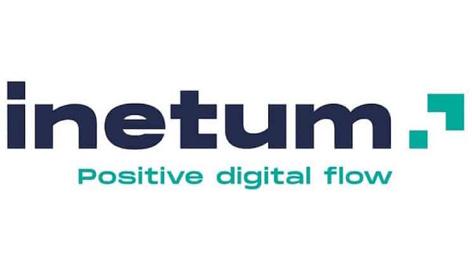

MEMBRES FONDATEURS MÉCÈNES PRIVÉS MÉCÈNES INSTITUTIONNELS

Strate Ecole de design, IMODEV, Club de Paris des Directeurs de l”Innovation, Grameen Crédit Agricole, PCA-STREAM, Académie de l”Entrepreneuriat et de l”In novation, Metropolis, Mandingo – Africa Web Festival, Les Ateliers, OuiShare, HETIC, Centre Yunus, Les Canaux, Institut Esprit Service, France urbaine, MegaCi ties-ShortDocs, Sorbonne Entrepreneur, Paris&Co, BIZERTE SMART CITY, AIVP, ADDHU, FIRA Barcelona México, AIMF, La Tribune, APUR, Women In Tech


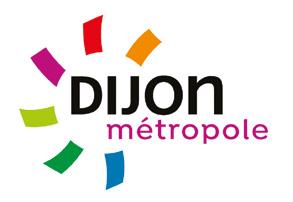




1. On this line of research, see the URBAN AI report (Hubert Beroche).
2. The Creative Evolution, H.Bergson
3. Town planning, Le Corbusier
4. In Amsterdam, Alessandro Bozzon (TU Delft) confided to me that “AI just predicts the past”.
5. The Atlas of Innovation Districts, Aretian
6. Suitcase word formed from smartphone and zombie to refer to city dwellers who are constantly looking at their phones.
7. Richard Sennett, Building and Dwelling: Ethics for the City (2018)
8. On the structuring nature of urban showcases and the influence of digital technology on them, we invite the reader to read this article
9. The theme of the face as an invitation to stroll in the city has been developed by Aragon in Aurélien
10. In Epicurean physics, clinamen refers to the deviation of atoms from their vertical fall into the vacuum. This clinamen breaks “the laws of fatality” (Lucretia), generates the meeting of bodies and gives birth to freedom.
11. Richard Sennett, Building and Dwelling: Ethics for the City (2018)
12. Germans like to say that “there is a wind of freedom blowing in the city” (Stadtluft macht fre).
13. T.Hobbes, Leviathan ( 1651)
14. This theme will be discussed in more detail in the Citizen City and AI chapter.
15. For more information on this point, we invite the reader to consult: Catherine Di”Ignazio, Eric Gordon and Elizabeth Christoforetti, Seamful Interfaces for A Community-Centered Smart City.
16. The situated citizien, Marius Hartmann in URBAN AI (Hubert Beroche)
17. For more information, see the “Human City” chapter in our previous notebook
18. See Cities at War: Global Insecurity and Urban Resistance (Saskia Sassen and Mary Kaldor).
19. On this point, see La “ ville sûre “ ou la gouvernance par les algorithmes (Félix Tréguer).
20. We take up here the concept of Bernard Stiegler, himself inspired by Jacques Derrida (Plato”s Pharma cy).
21. Prison architecture allowing to see without being seen. On this point see Surveiller et Punir (M.Fou cault)
22. Idea notably developed by Jane Jacobs with her concept of the “eyes of the street” in Decline and Survival of the big American cities.
23. Takeshi Sakaki, Makoto Okazaki and Yutaka Matsuo, Tweet Analysis for Real-Time Event Detection and
NotesEarthquake Reporting System Development
24. Concept first discovered with Greg Lindsay in Montreal
25. If an individual has “liked” more than 300 pages on Facebook, it is possible to predict their psycholo gical profile with 95% accuracy, their sexual orientation (93%) and their ethnic gender (95%). Michal Kosinski, David Stillwell and Thore Graepel, Private traits and atrributes are predictable from digital records of human behaviour.
26. Brian David Johnson, Engineering a Traitor (2018)
27. Comments by Greg Lindsay reported as part of the Urban AI report
28. Saskia Sassen, Urban Capabilities : An Essay on Our Challenges and Differences
29. At least two can be cited: the “self-fulfilling” prophecy (Robert K. Merton) and the “scapegoat” (René Girard).
30. The fight against fake news is not without recalling the myth of the cave (The Republic, Plato).
31. Although the official argument is budgetary
32. See the example of Predpol in the chapter “Protective City”.
33. See the chapter “Living Cities” with the example of Cityscope.
34. Roger Ulrich, Xiaobo Quan, Craig Zimring, Anjali Joseph, Ruchi Chouhary, The Role of the Physical Environment in the Hospital of the 21st Century: A Once-in-a-Lifetime Opportunity
35. On this point see : Christopher Alexander, A City is not a Tree (1965)
36. Rousseau, Du Contrat Social
37. See Luc Julia”s contribution in URBAN AI (Hubert Beroche).
38. On this point see the interview of François Chollet in the Appendix.
39. Just Raimbault, Joris Broere, Marius Someveille, Jesus Mario Serna, Evelyn Strobom, Christine Moore, Ben Zhu, Lorraine Sugar, A spatial agent based model for eco-industrial systems
40. Daniel Castro-Lacouture, Steven Jige Quan, Perry Pei-JU Yang, GIS-BIM framework for integrating ur ban systems waste stream and algal cultivation in residential construction
41. Kevin Lync (1960), The Image of the City
42. Francesco Careri, Walkscapes: Walking as an Aesthetic (2002)
43. Ibid
44. Carlo Ratti and Matthew Claudel, The City of Tomorrow: Sensors, Networks, Hackers and the Future of Urban Life
